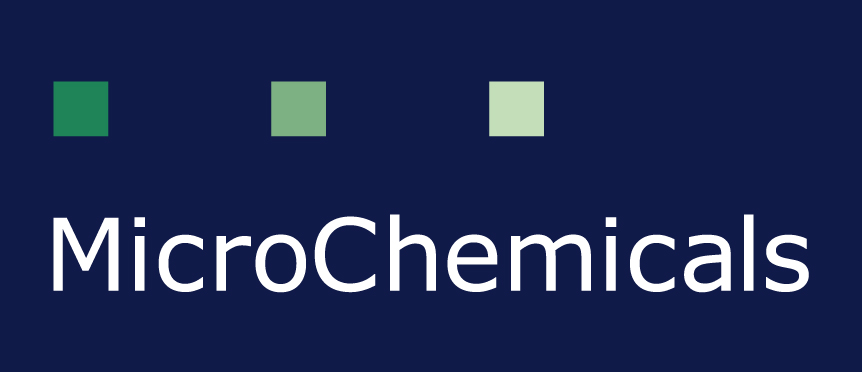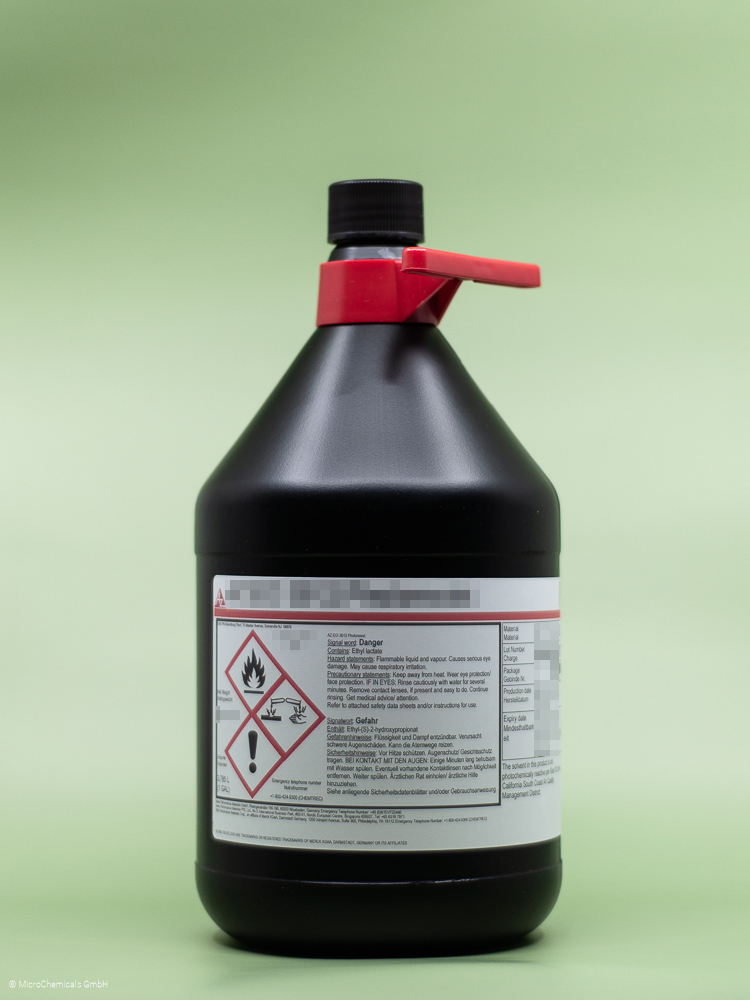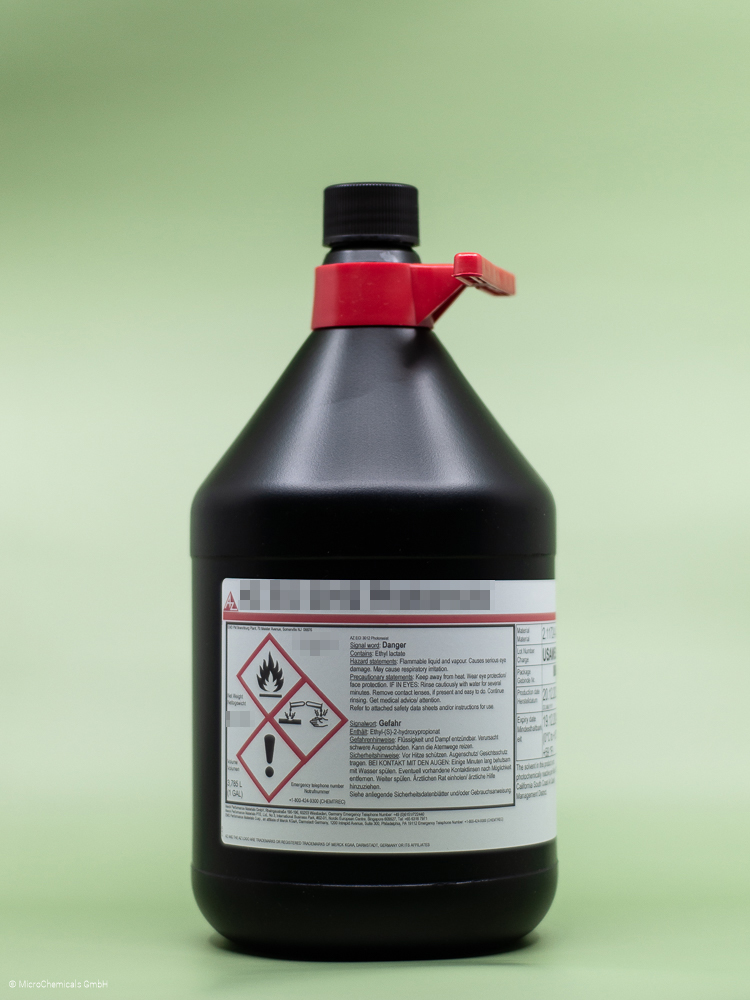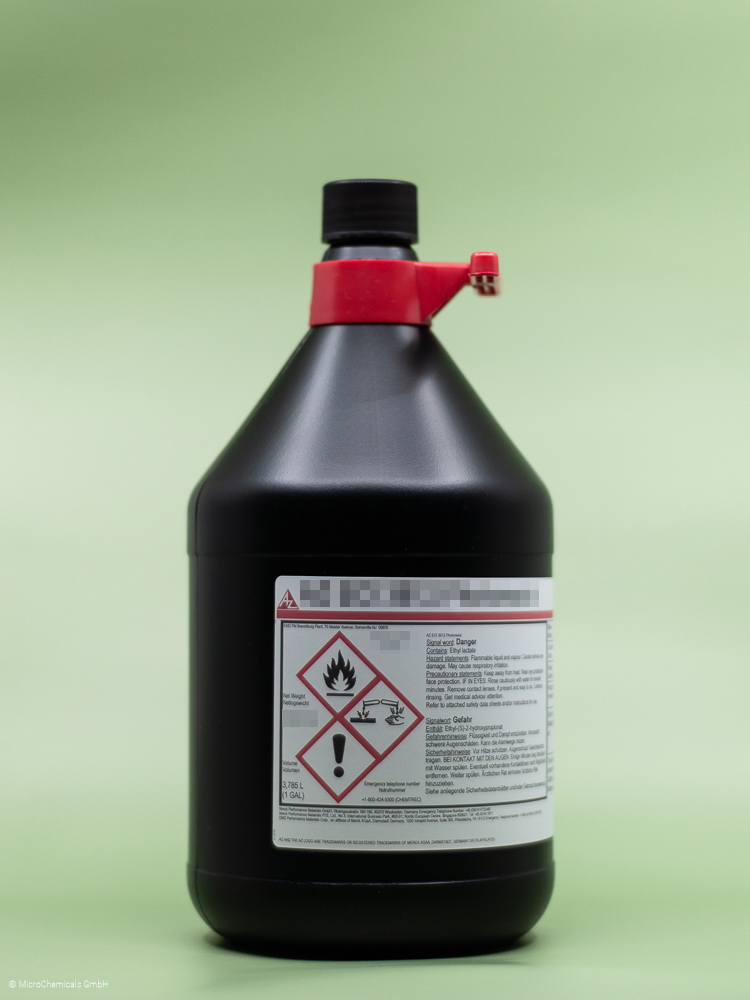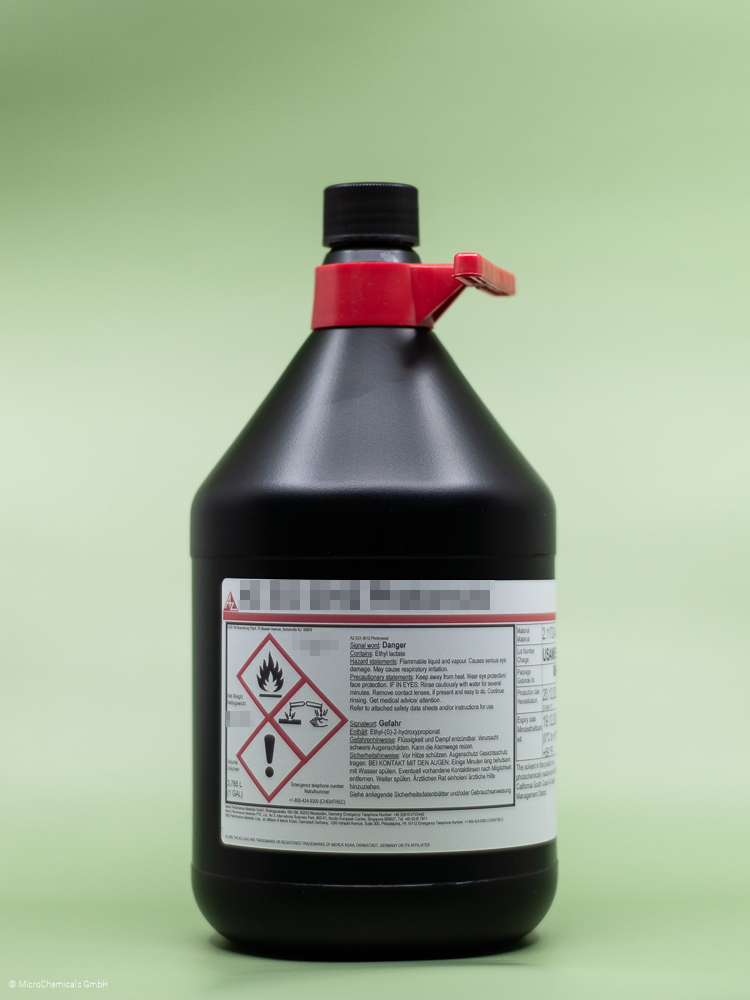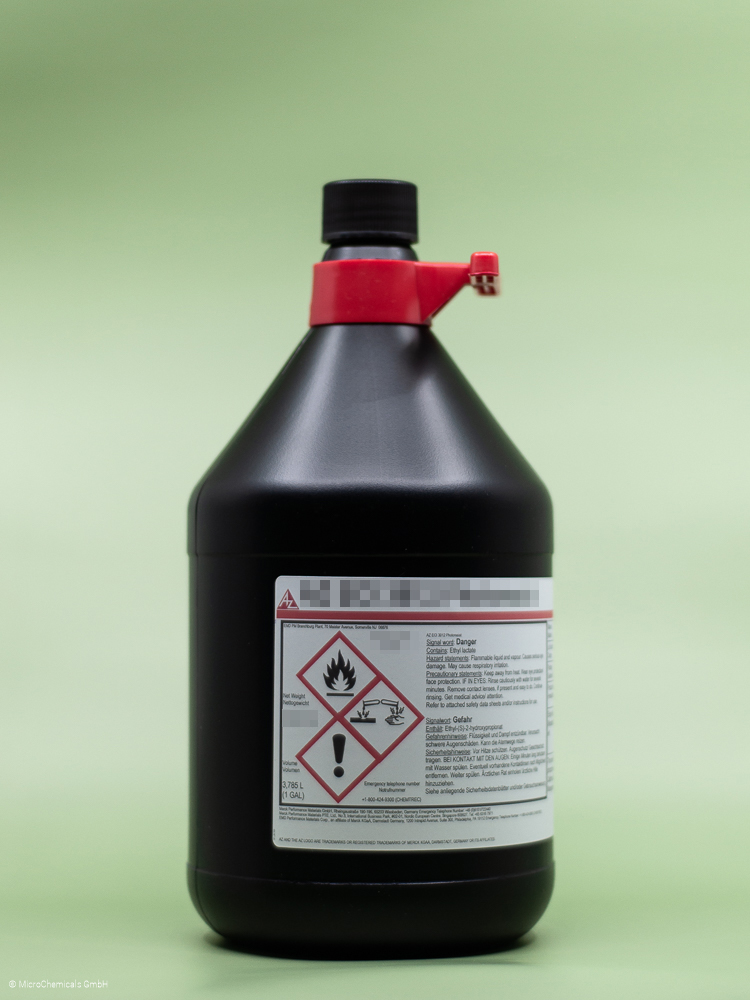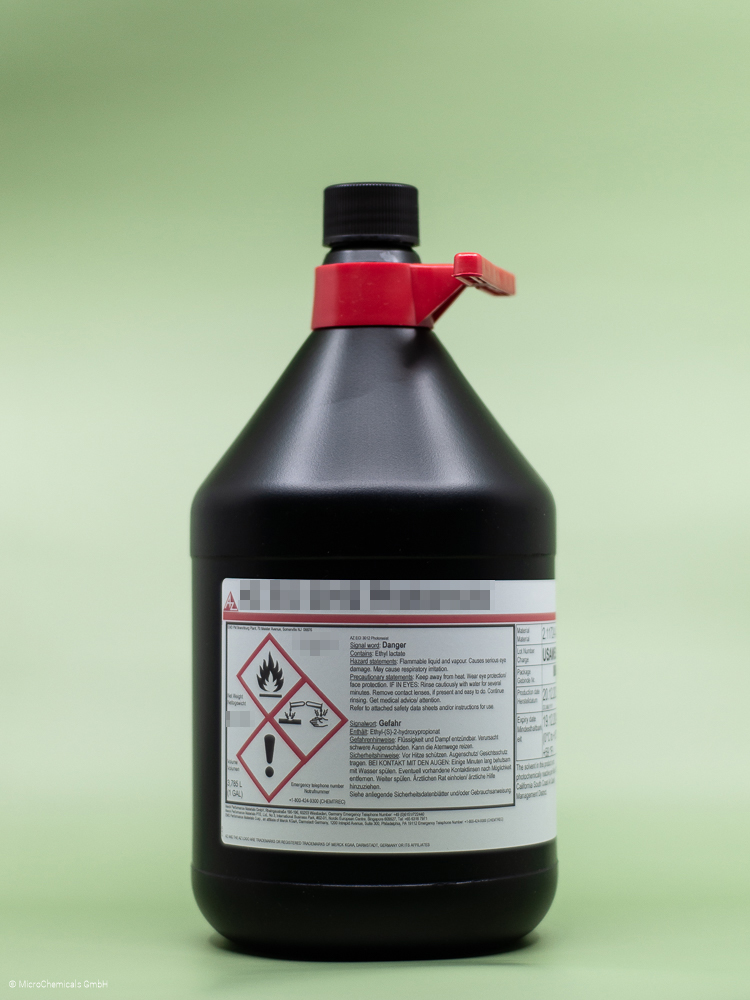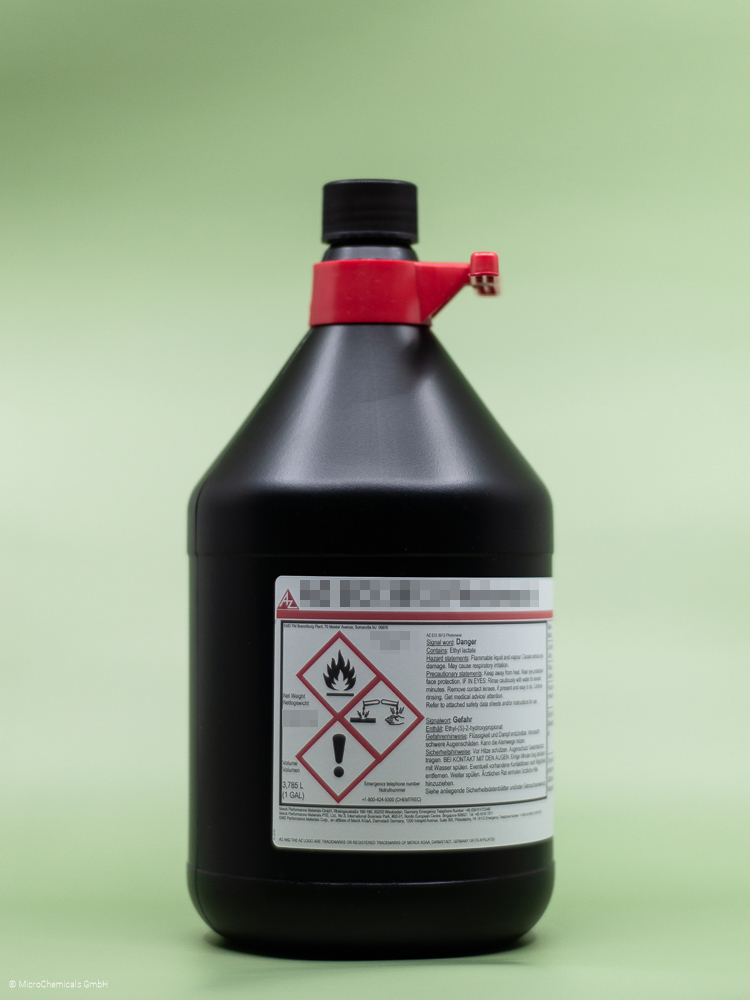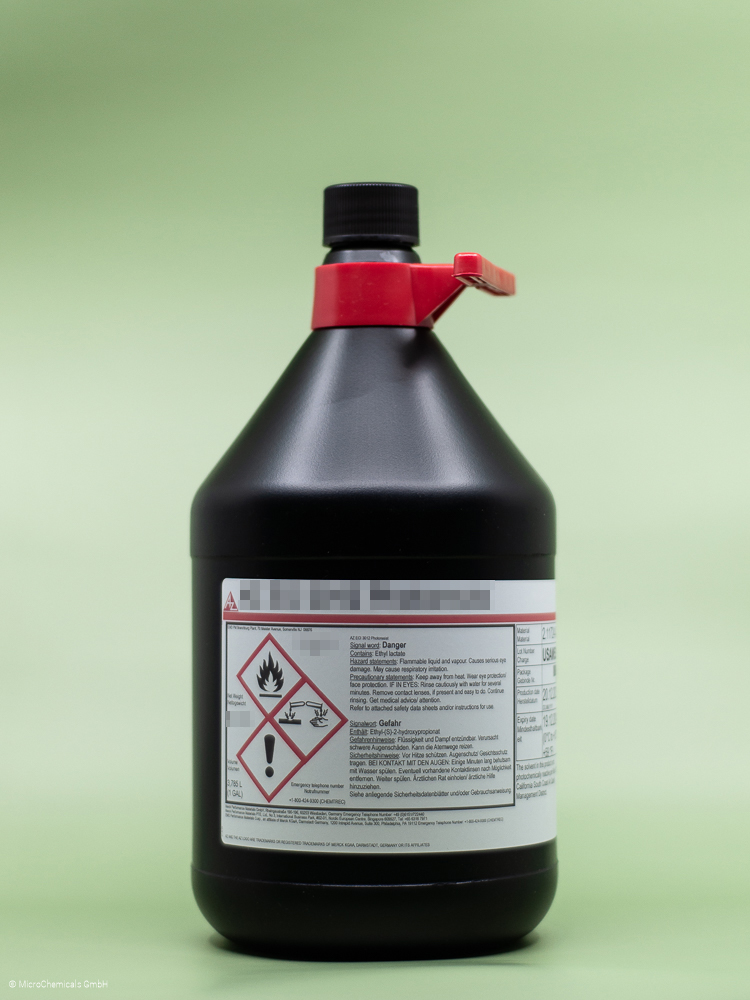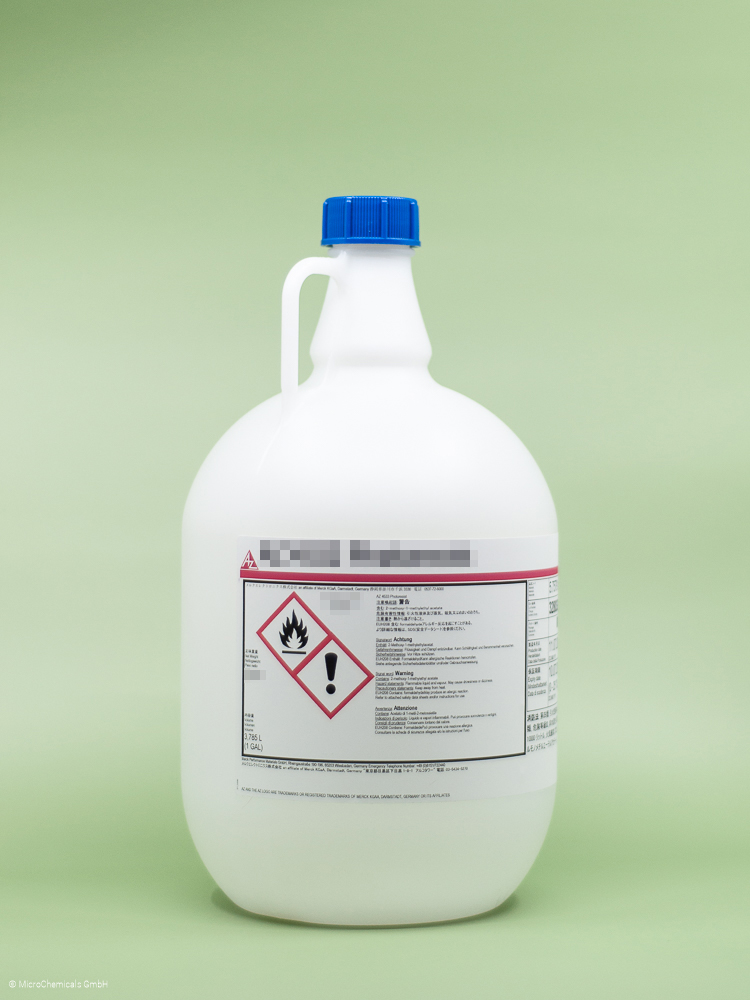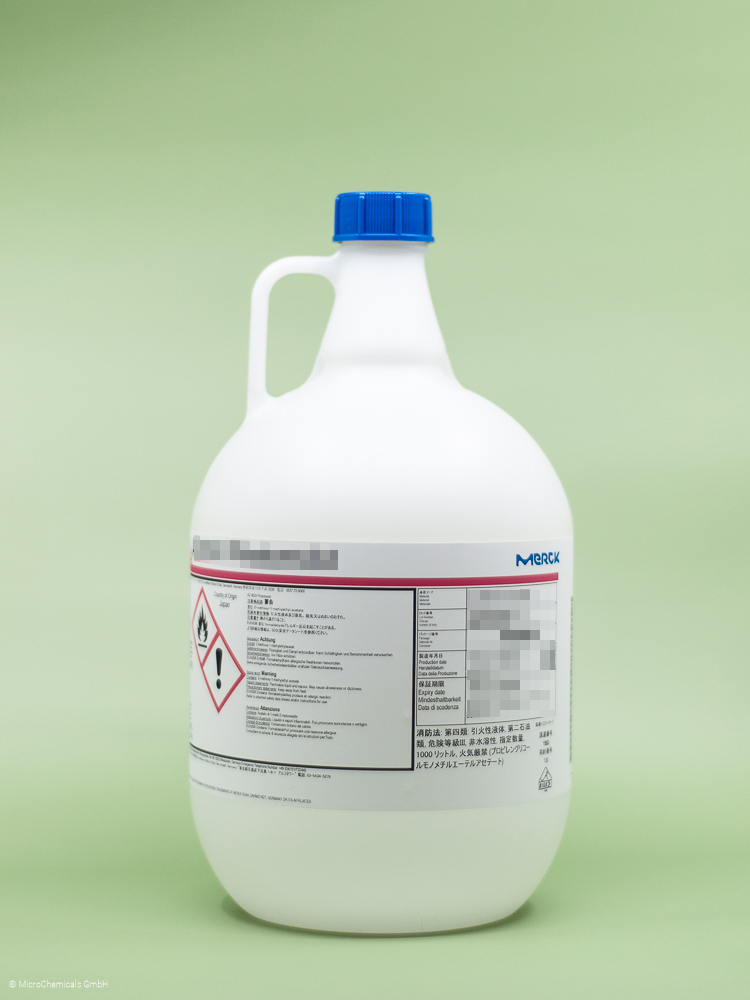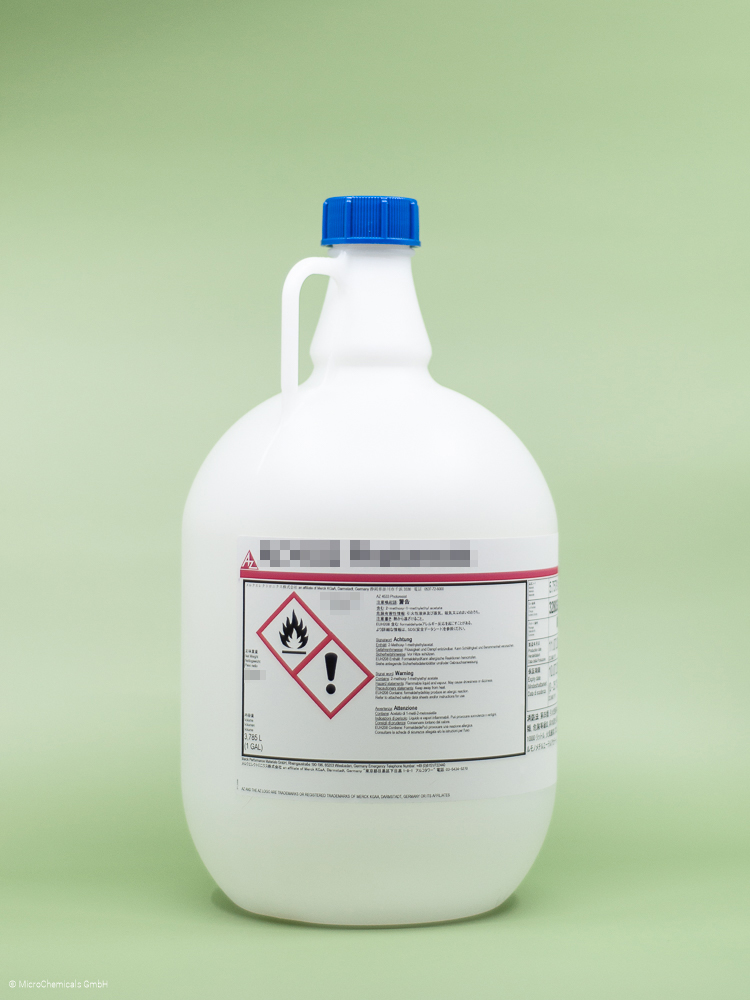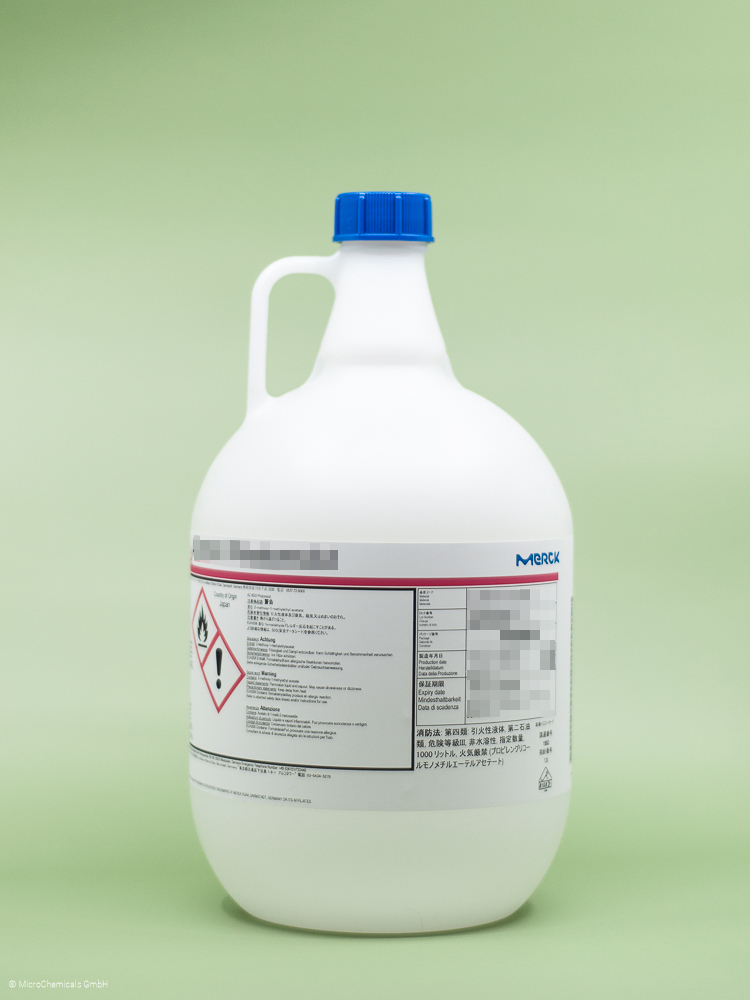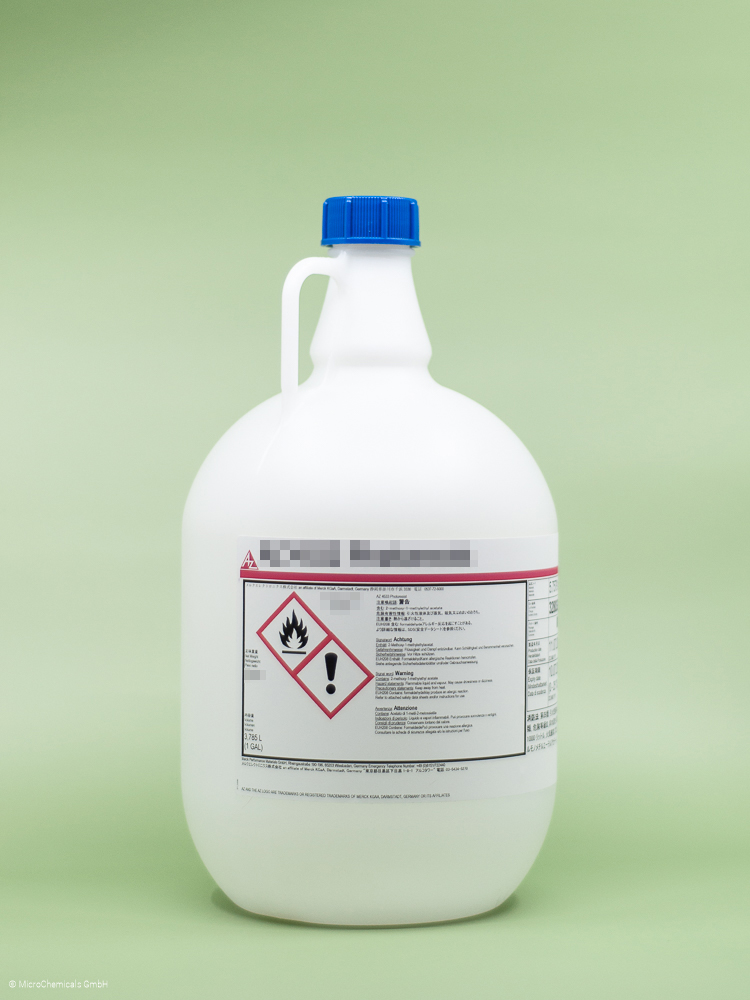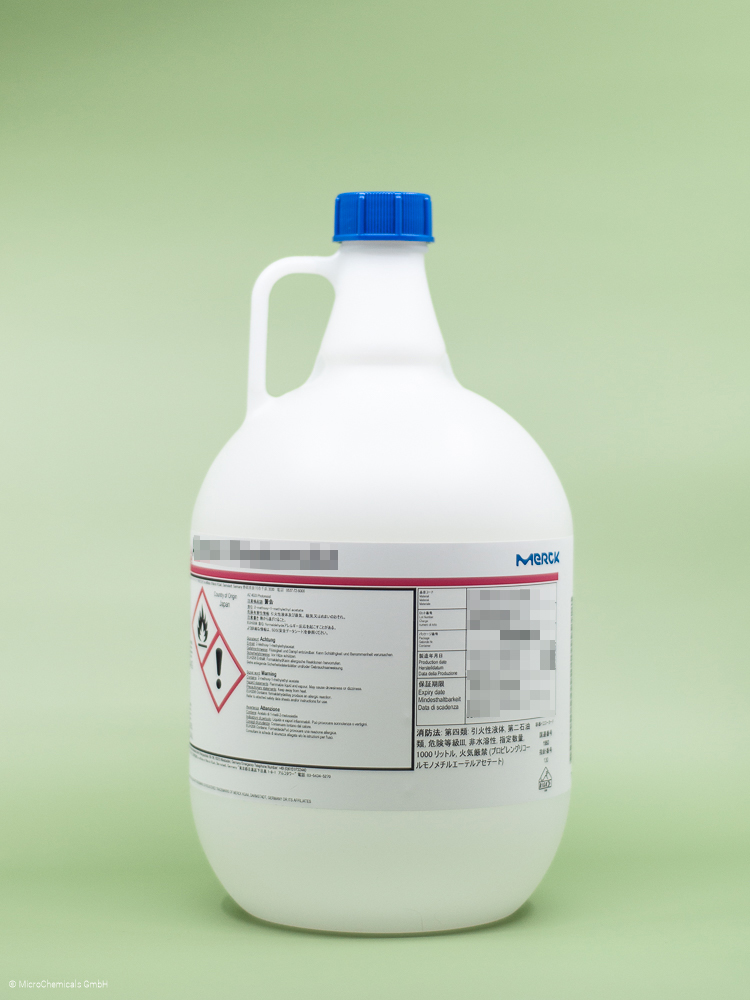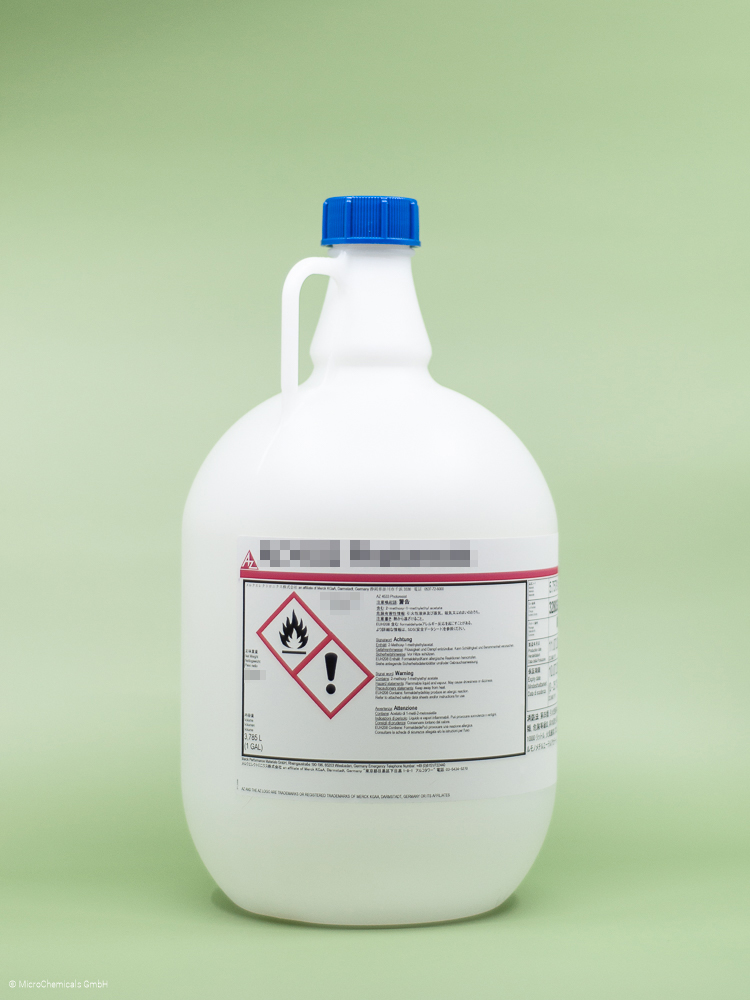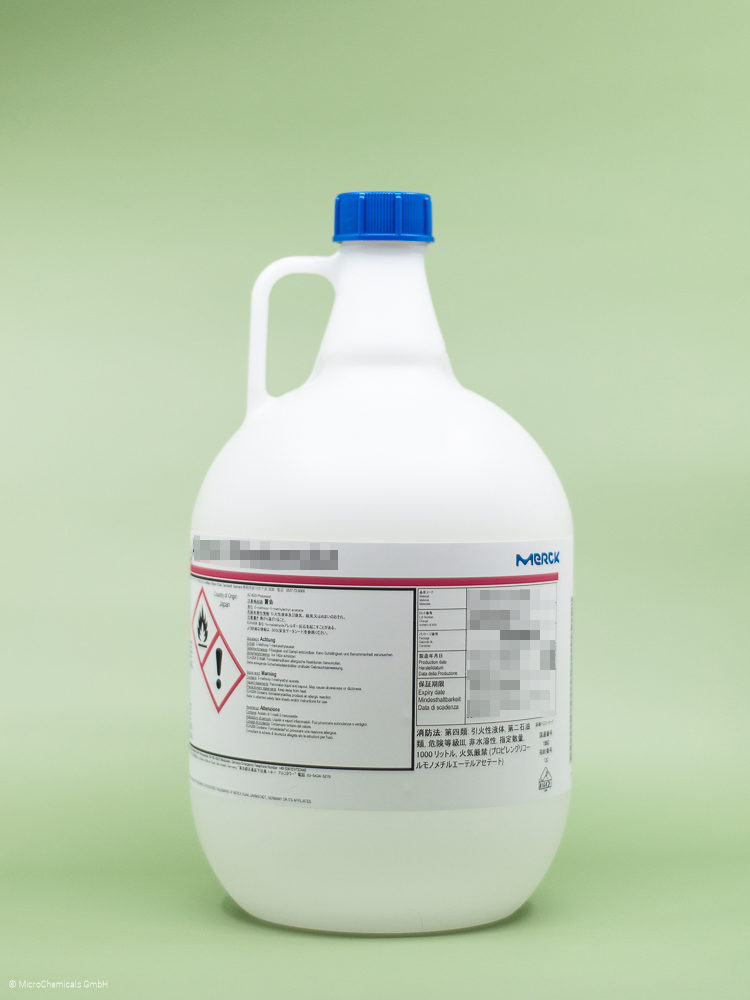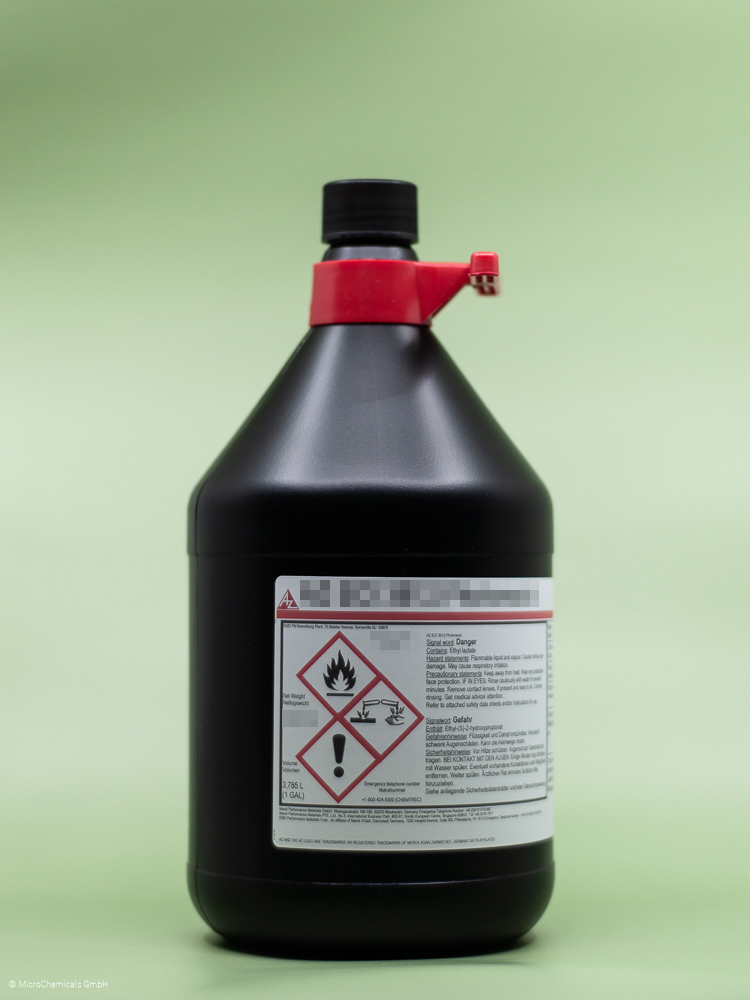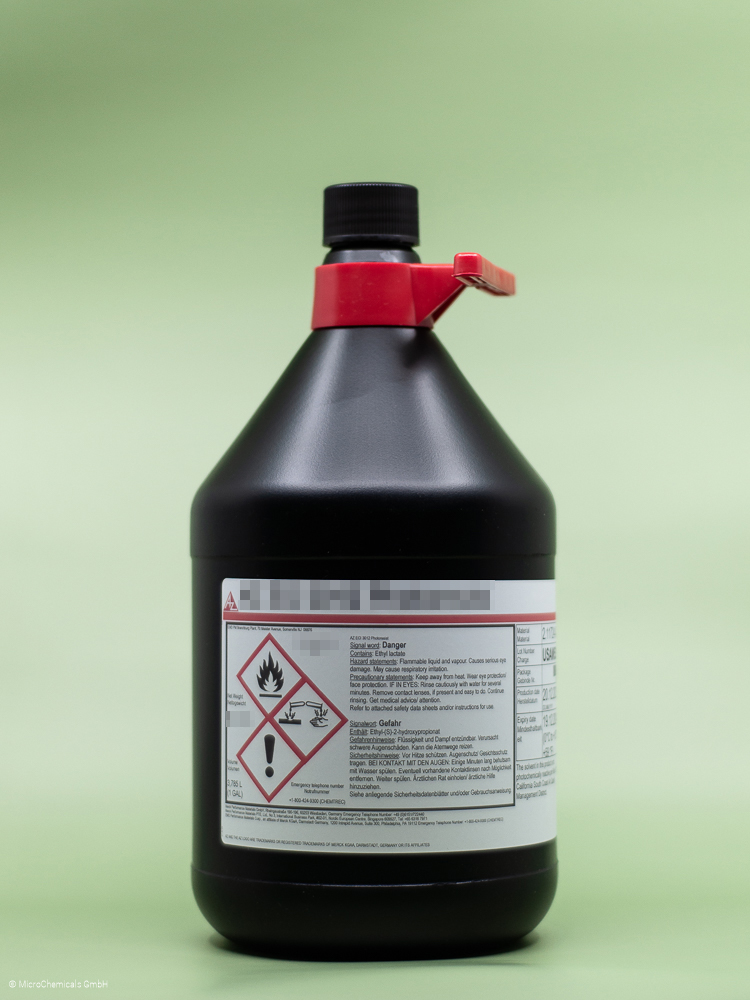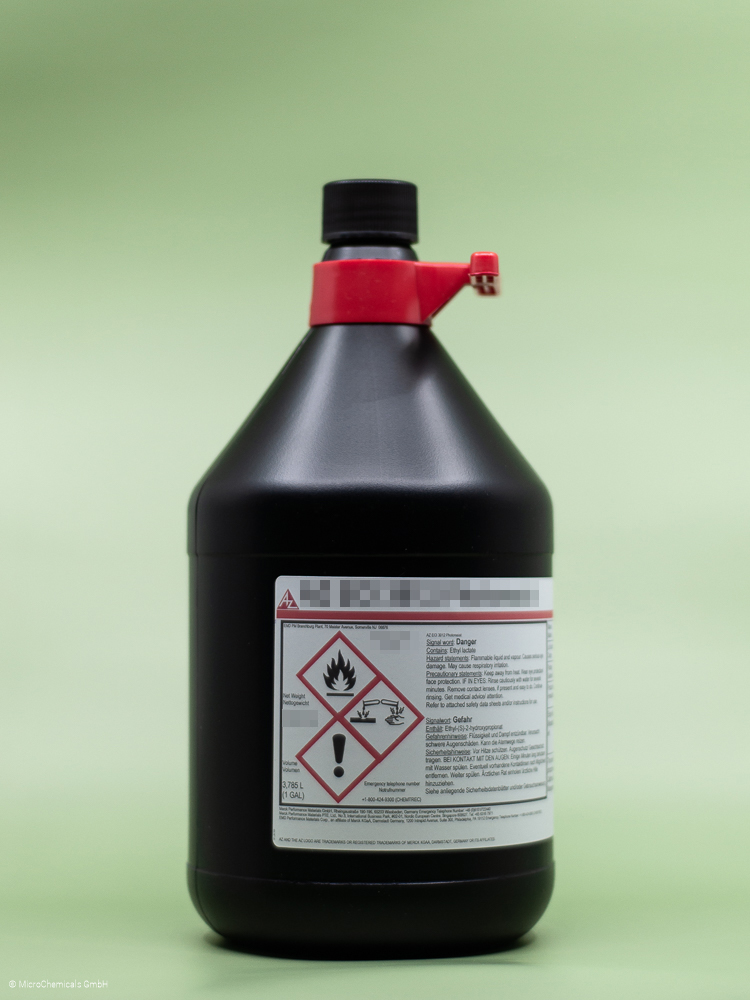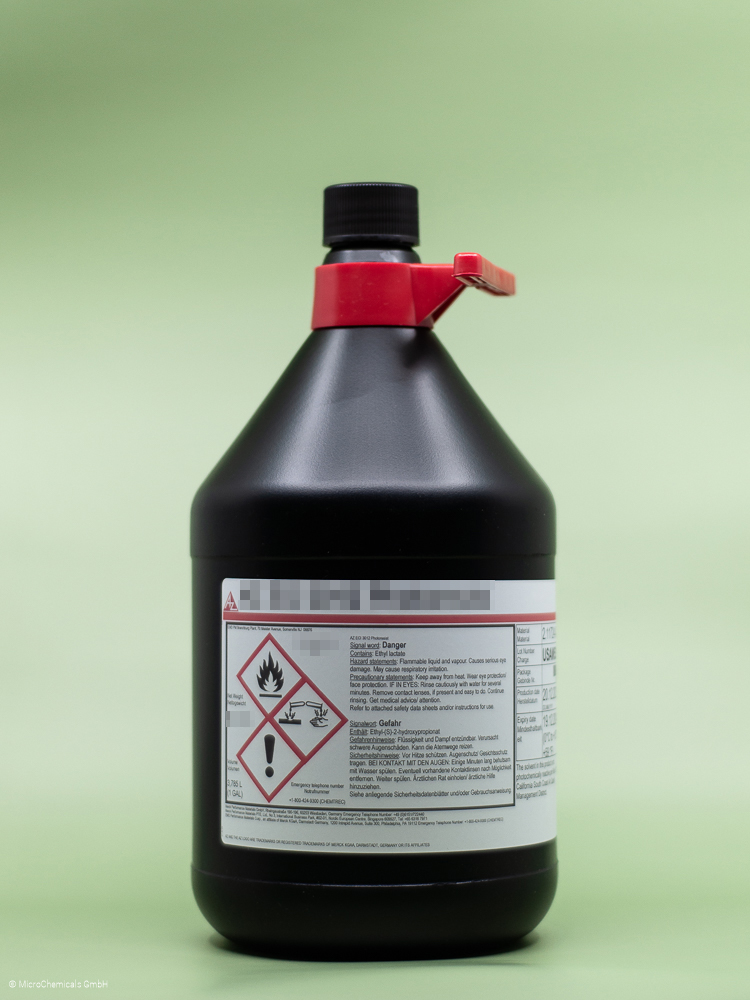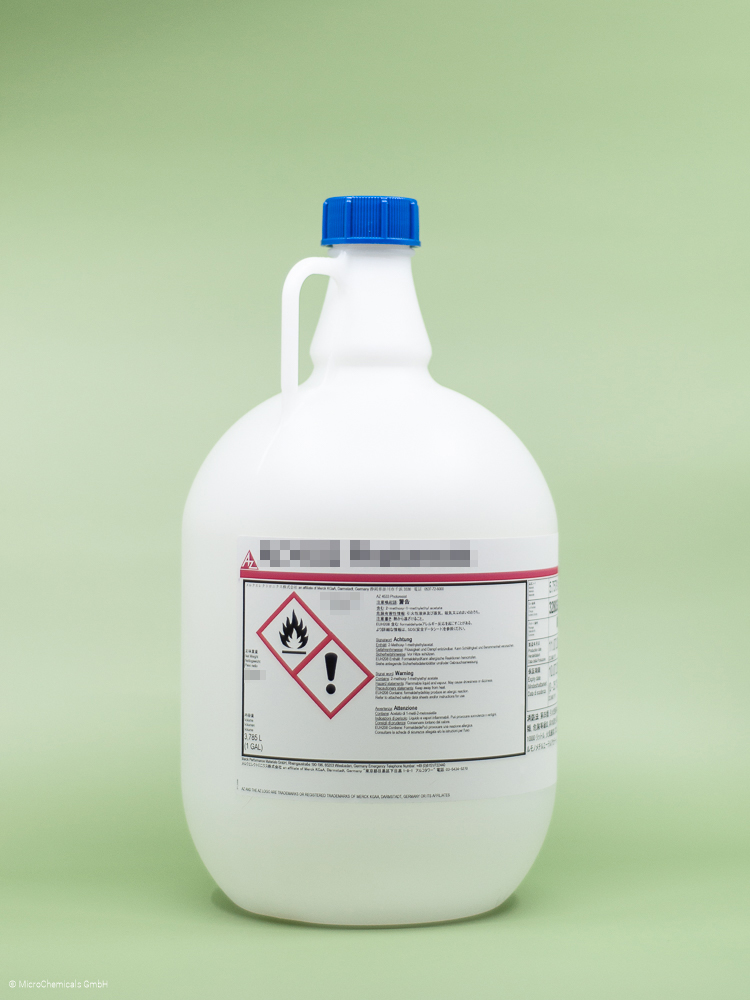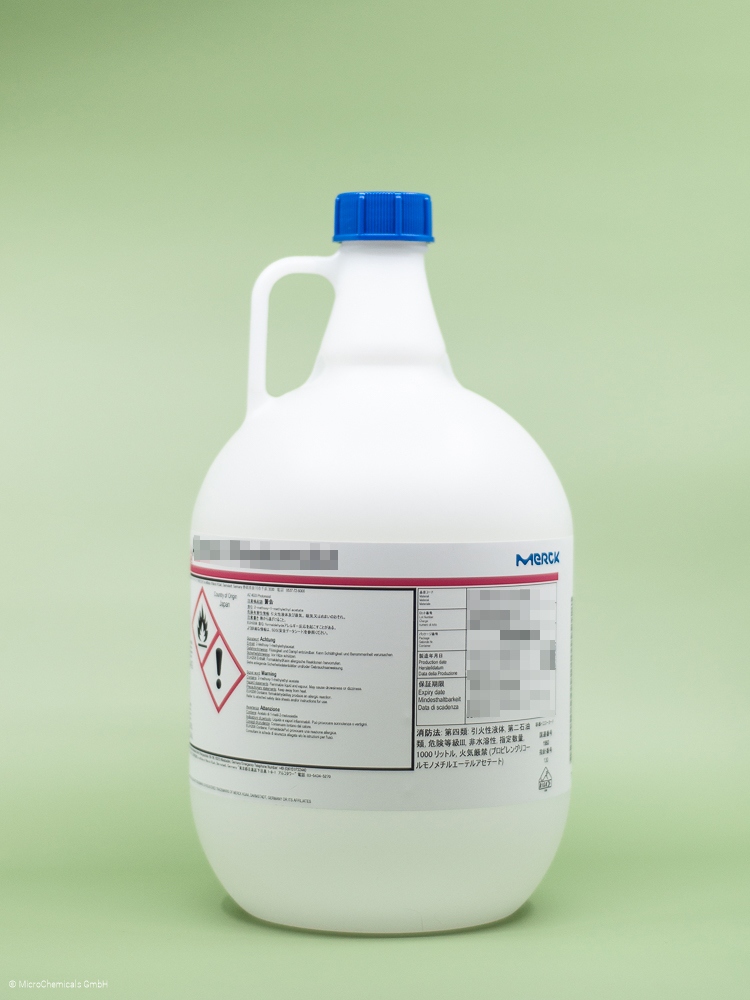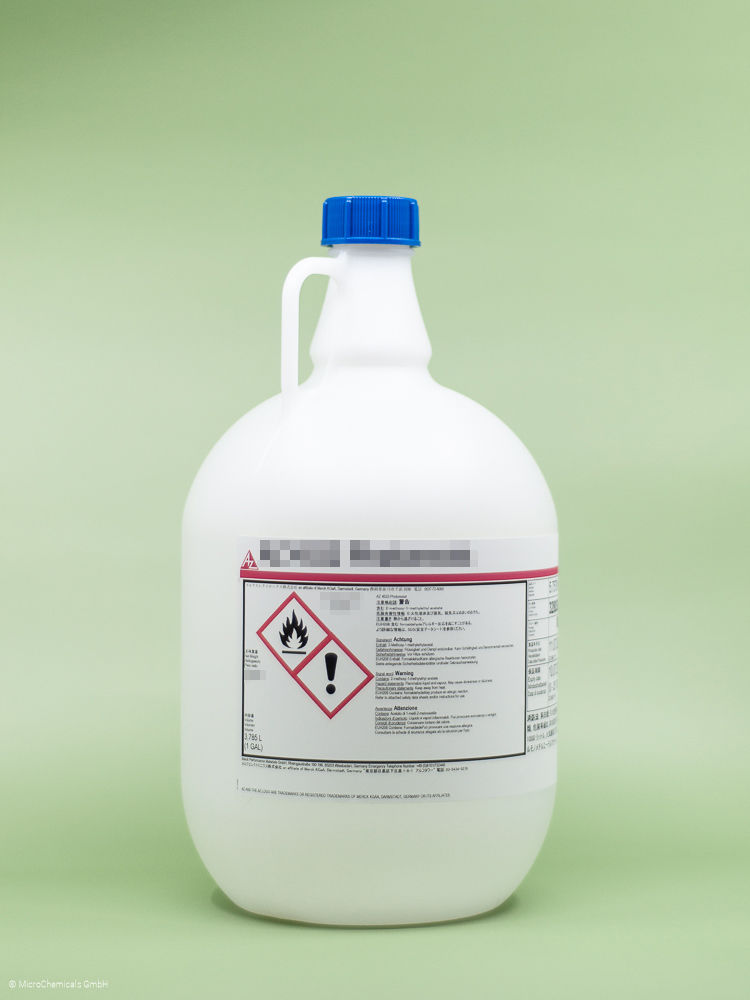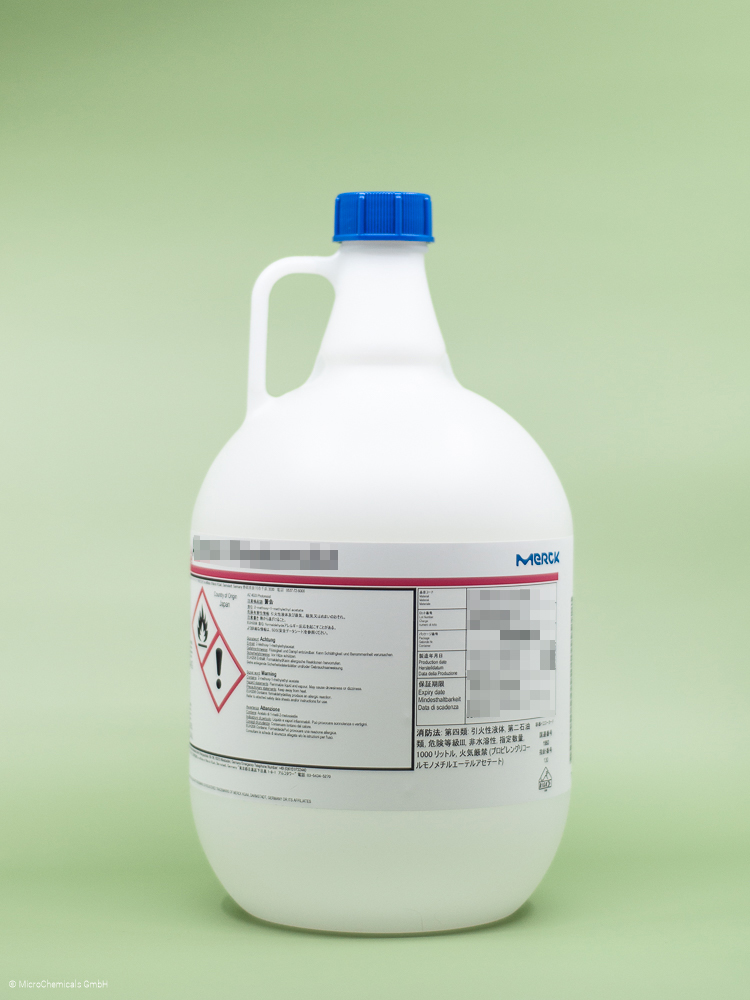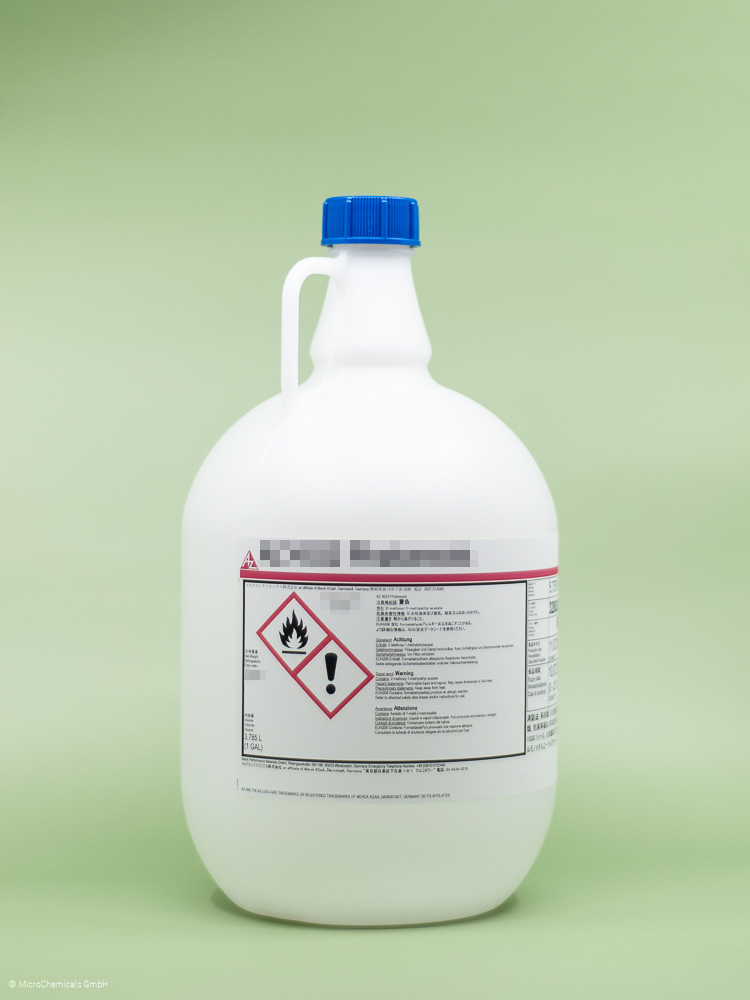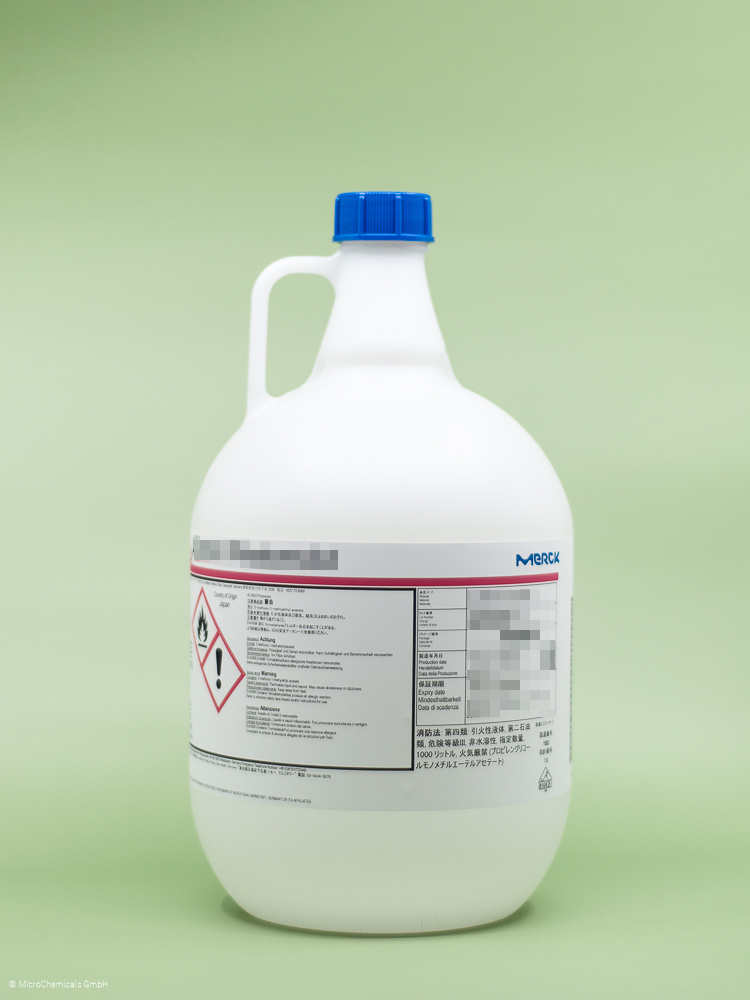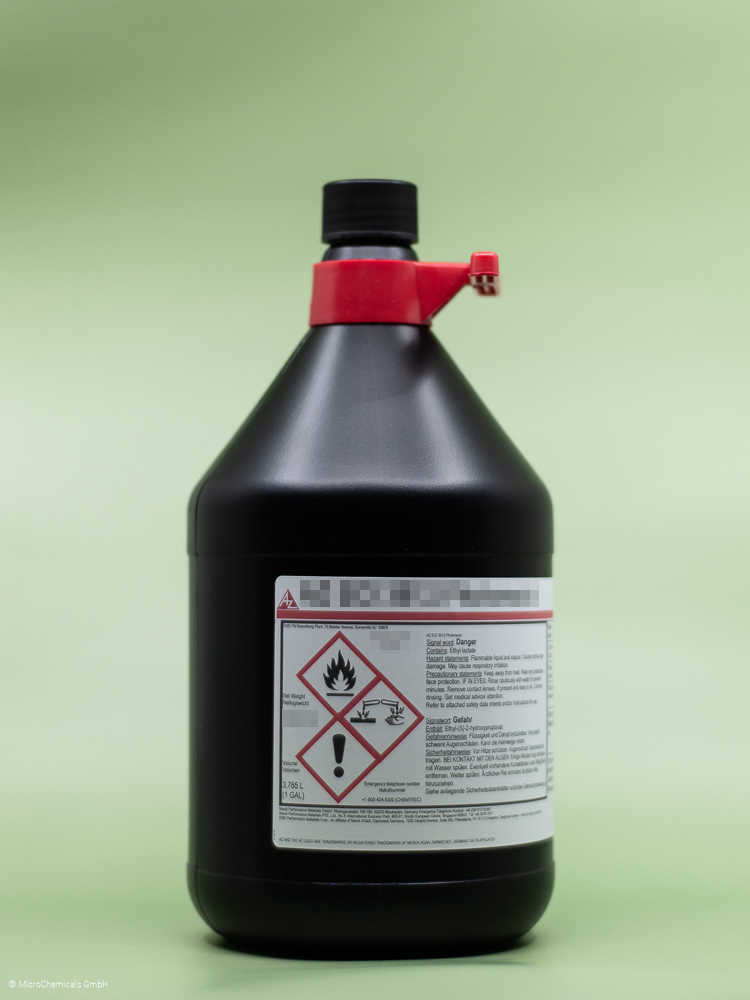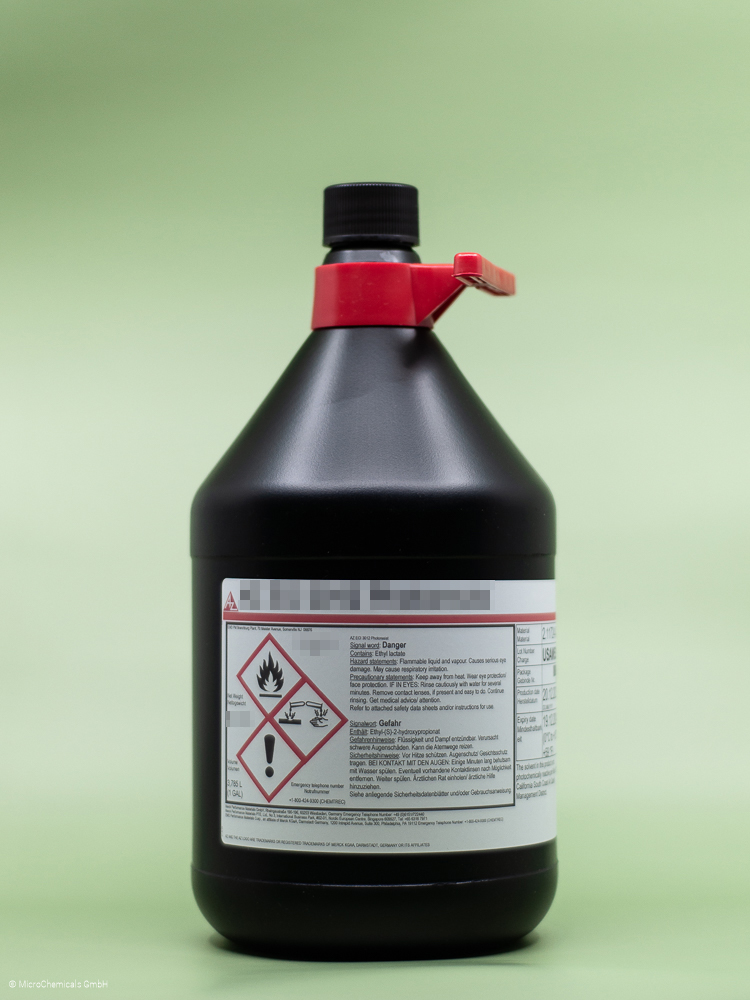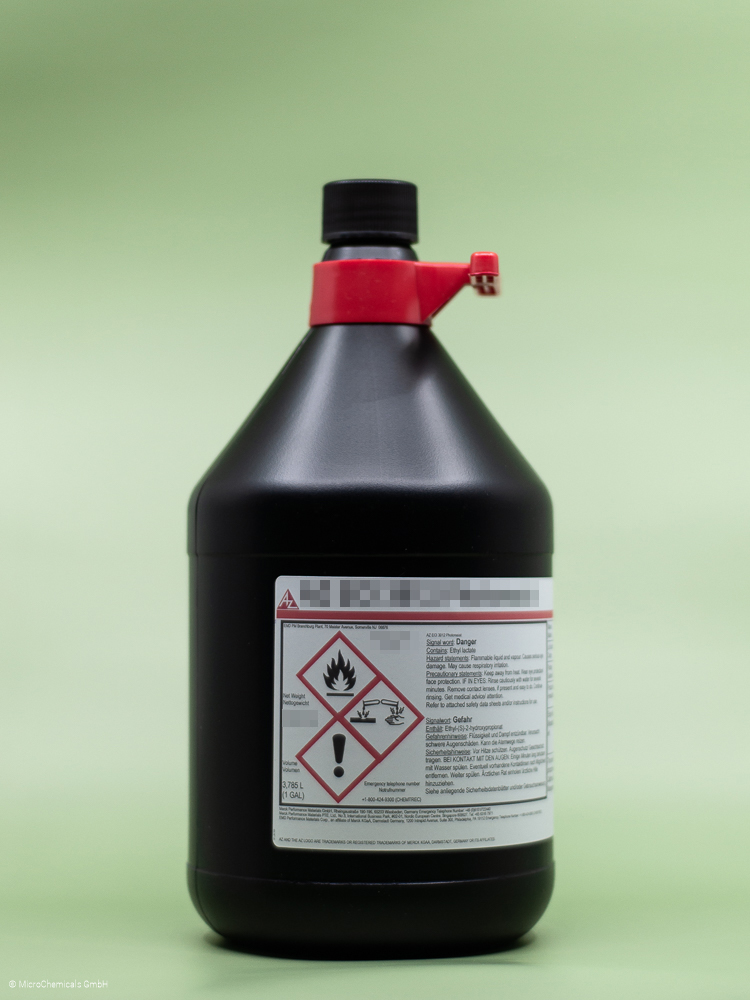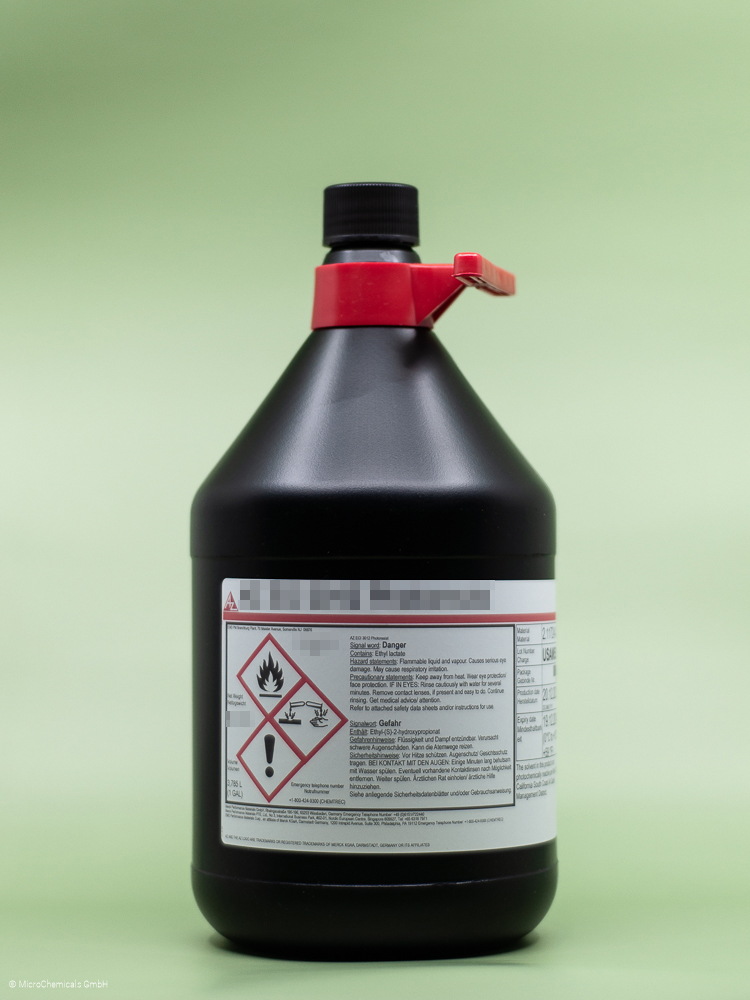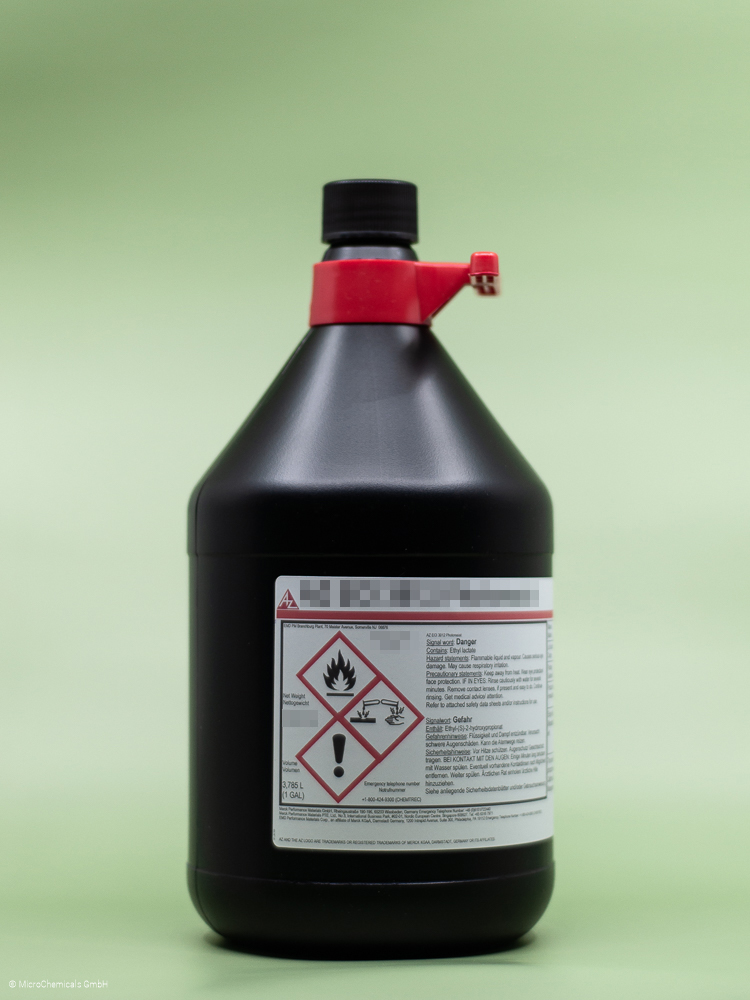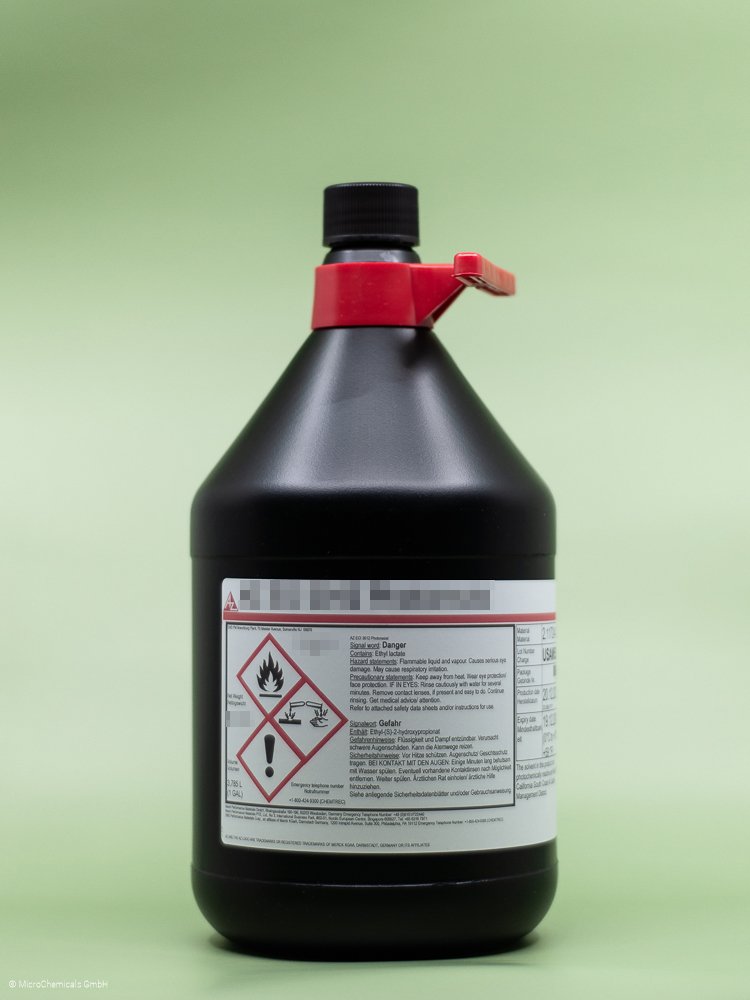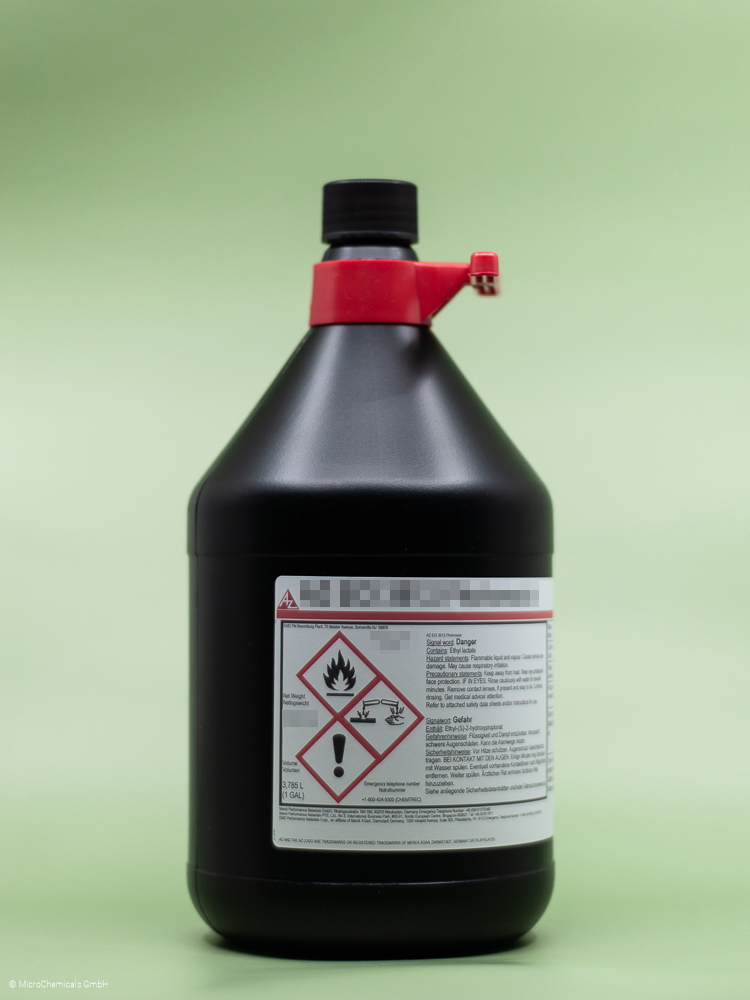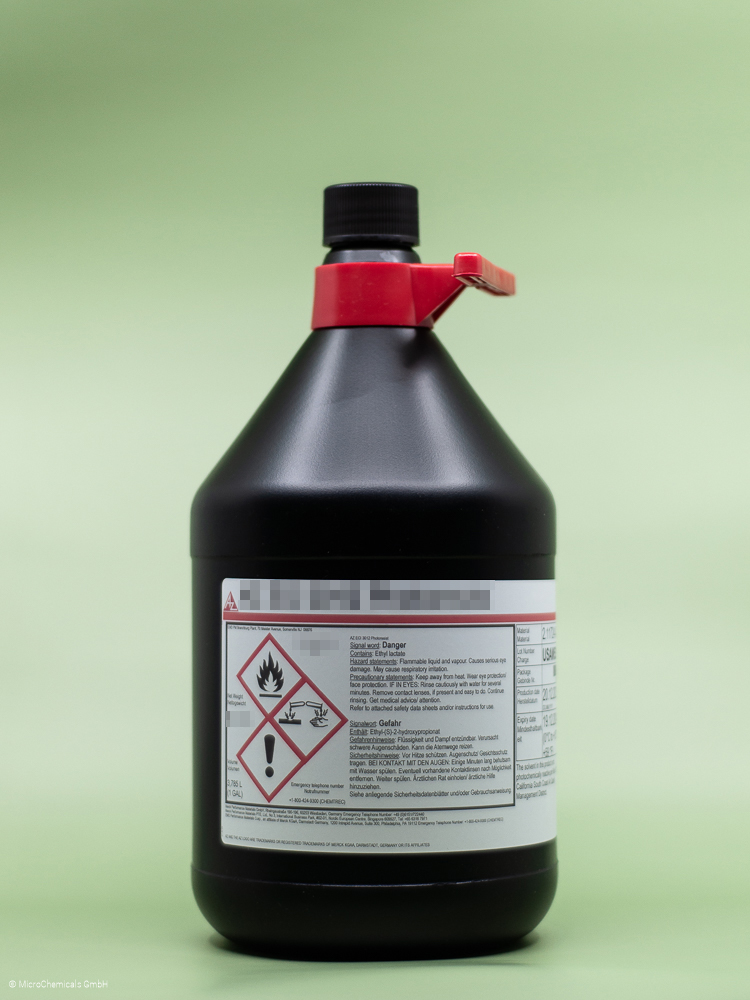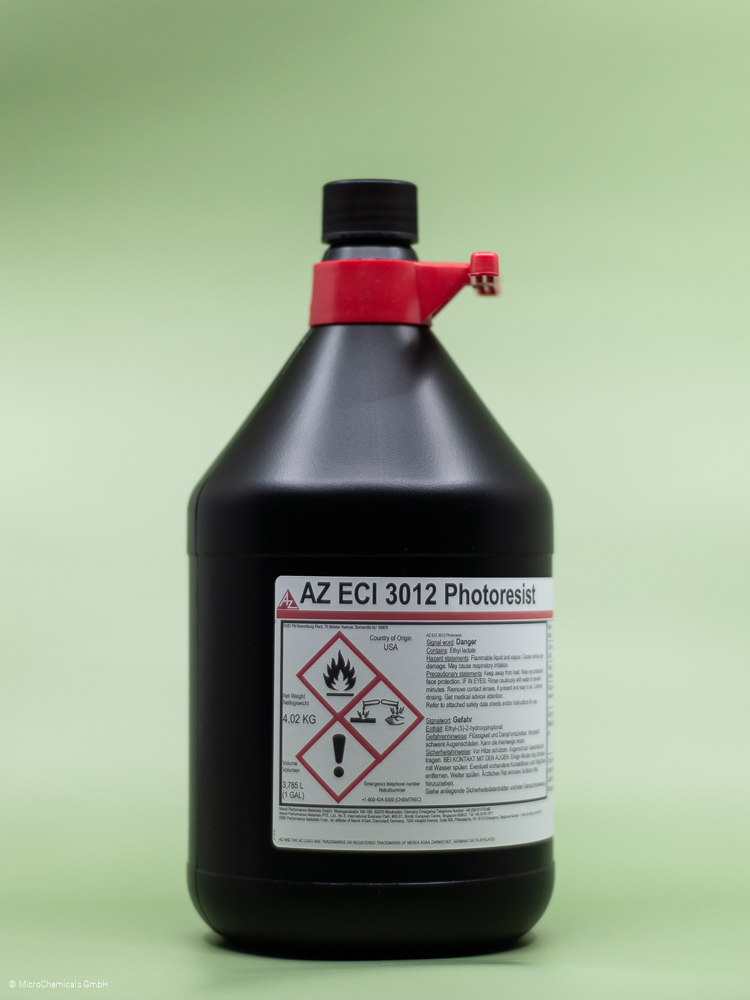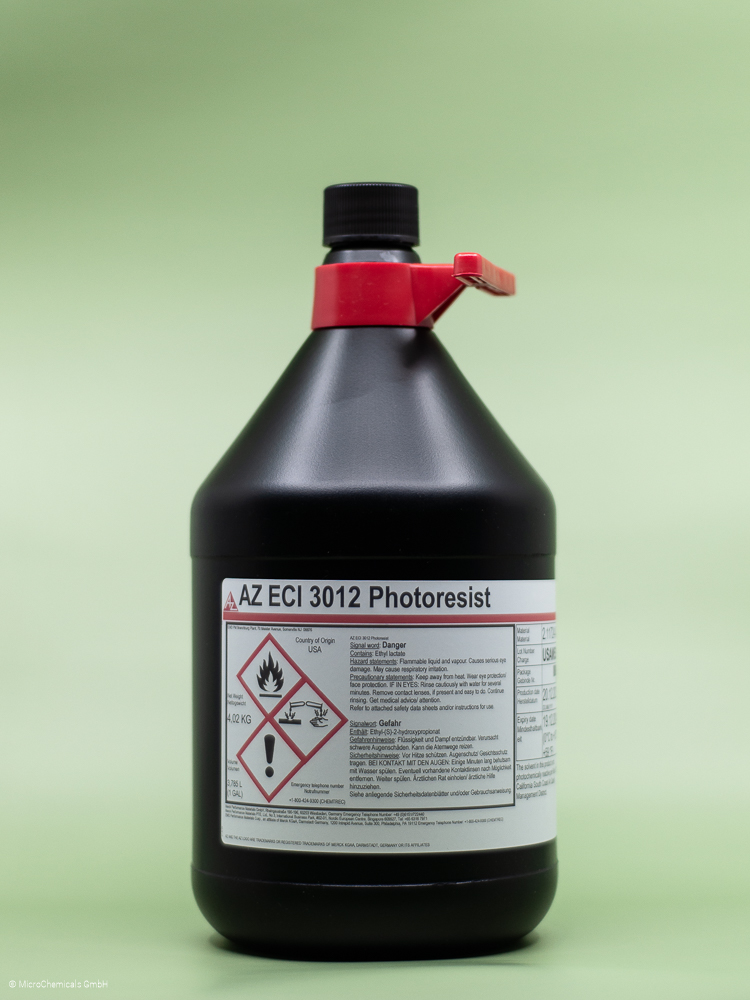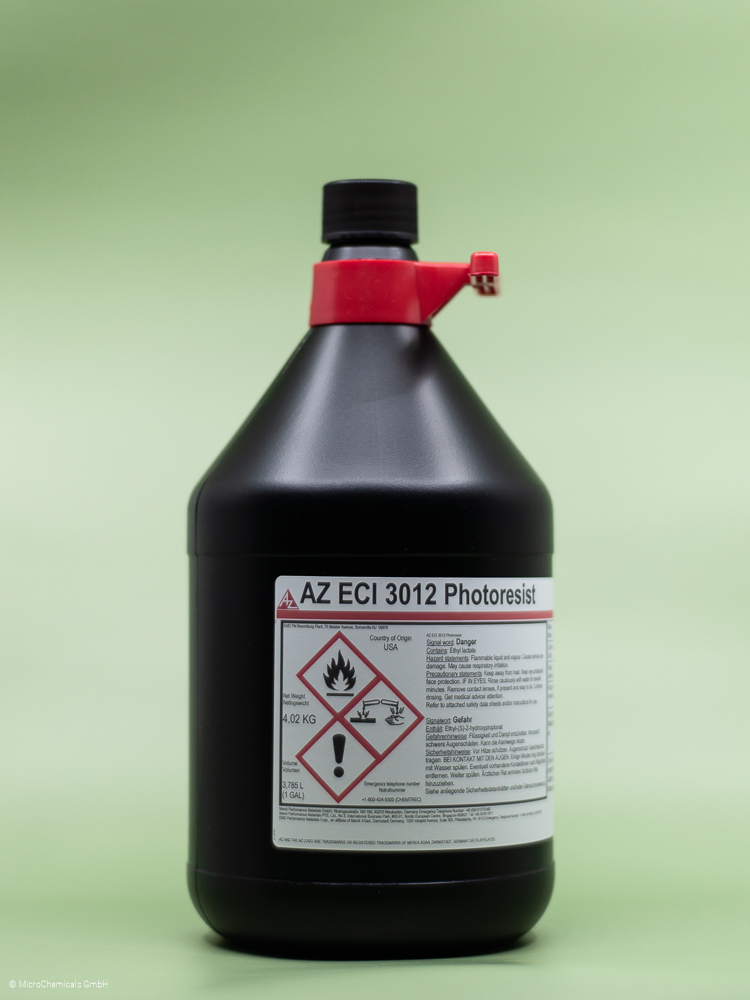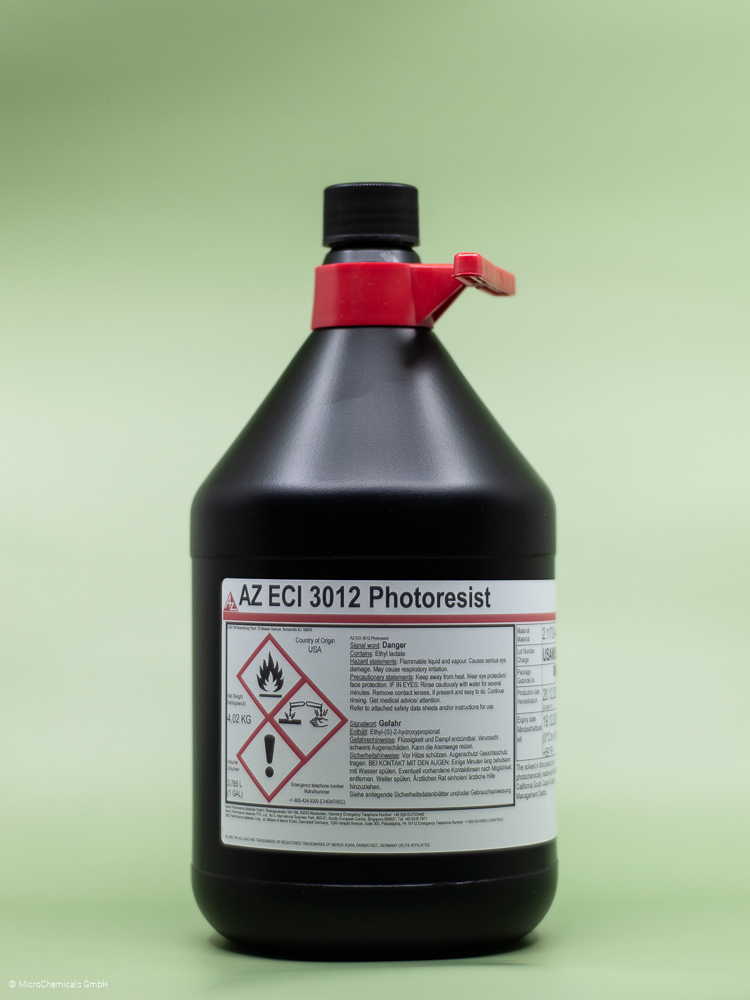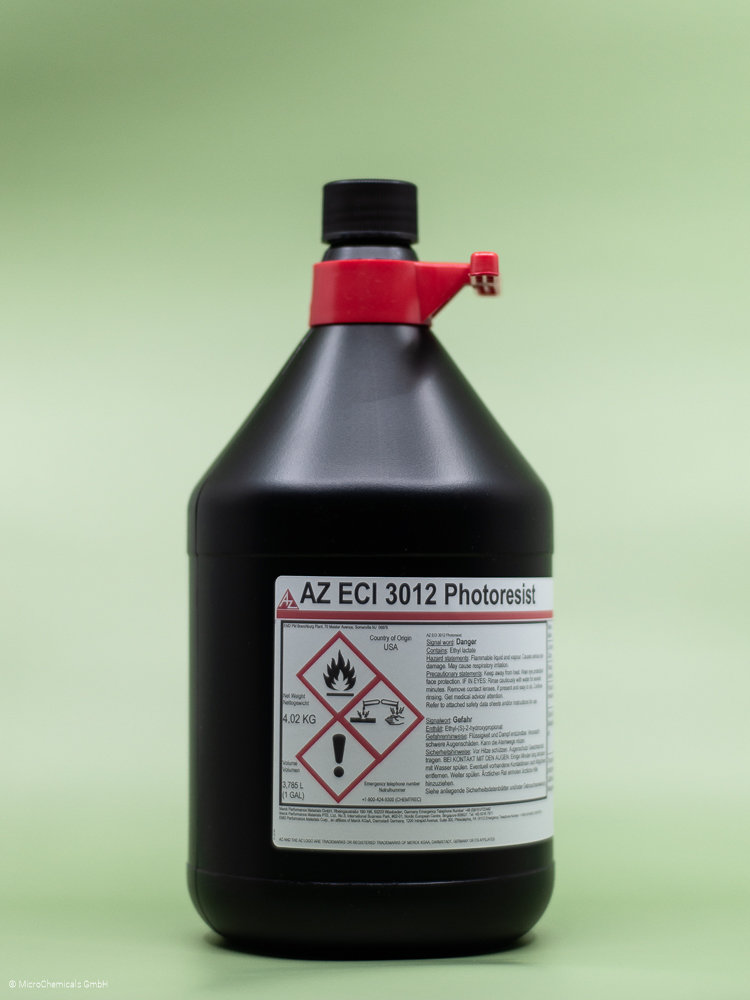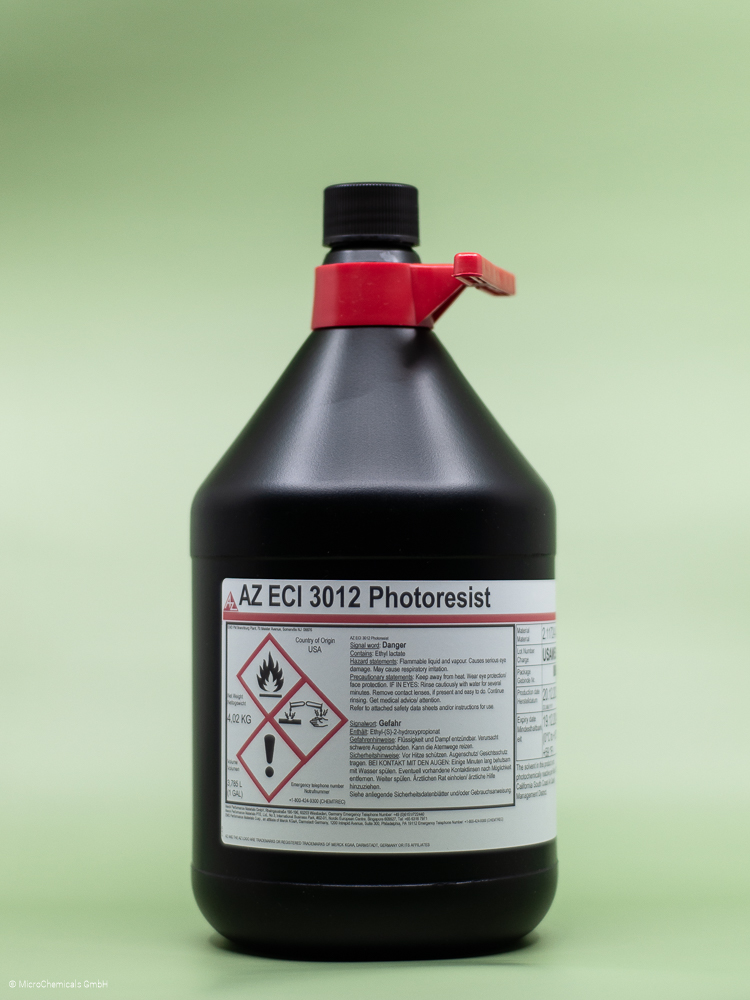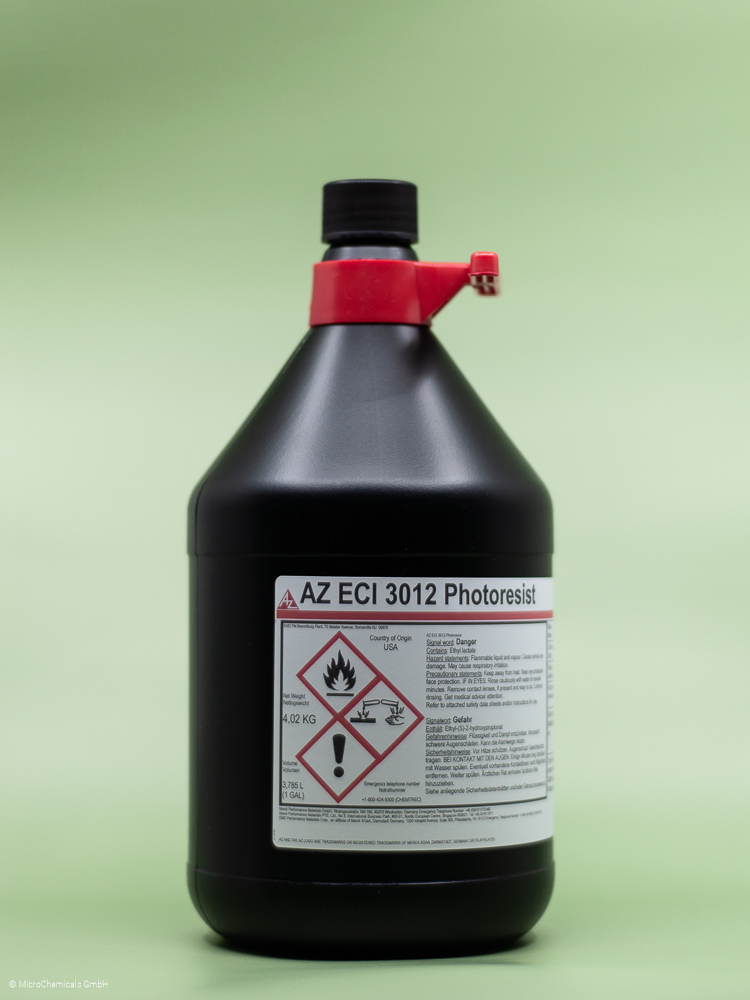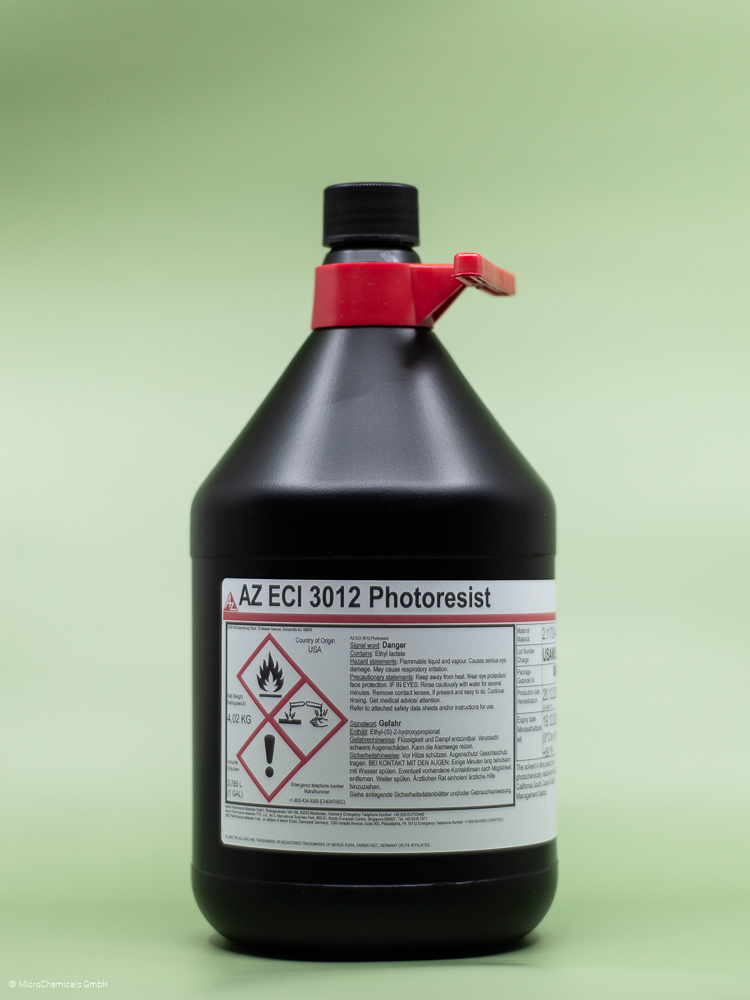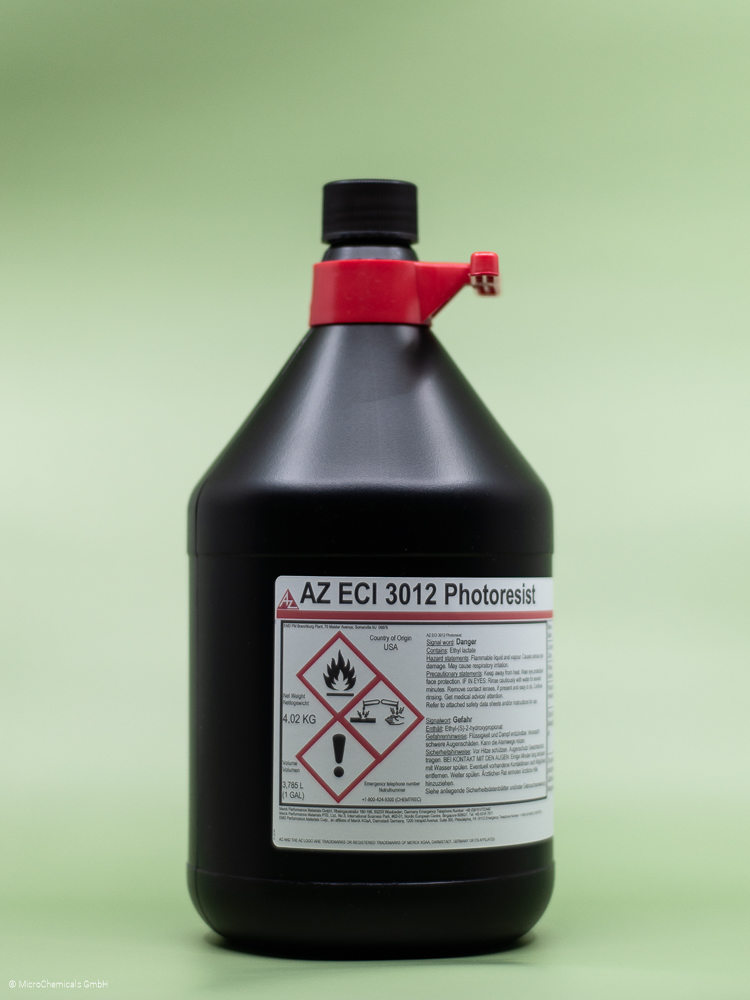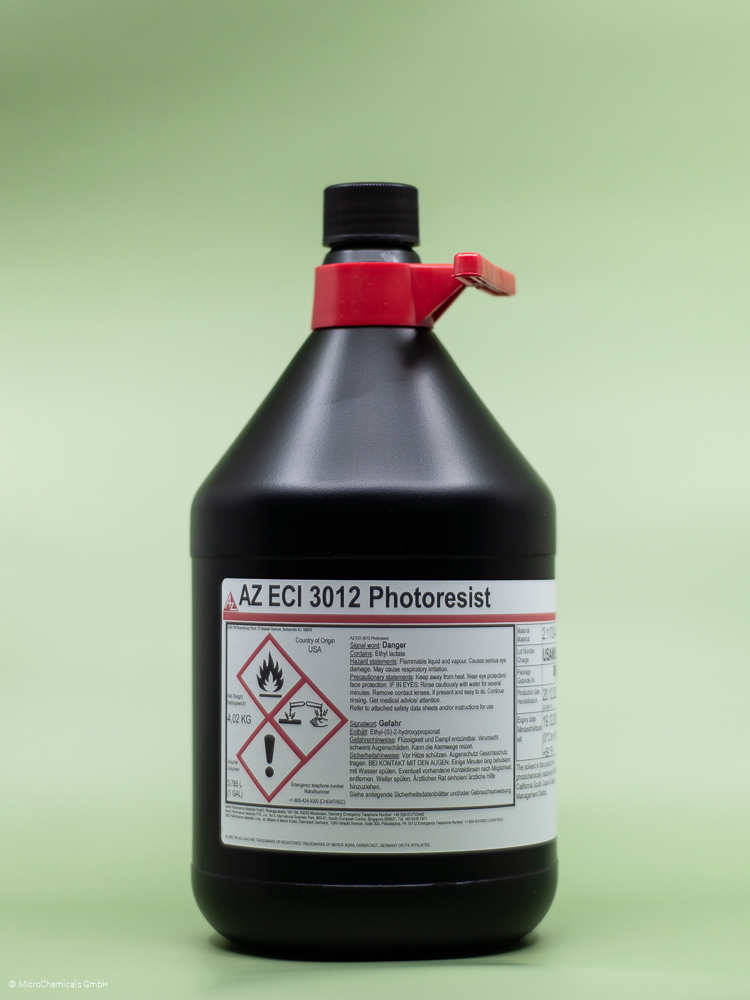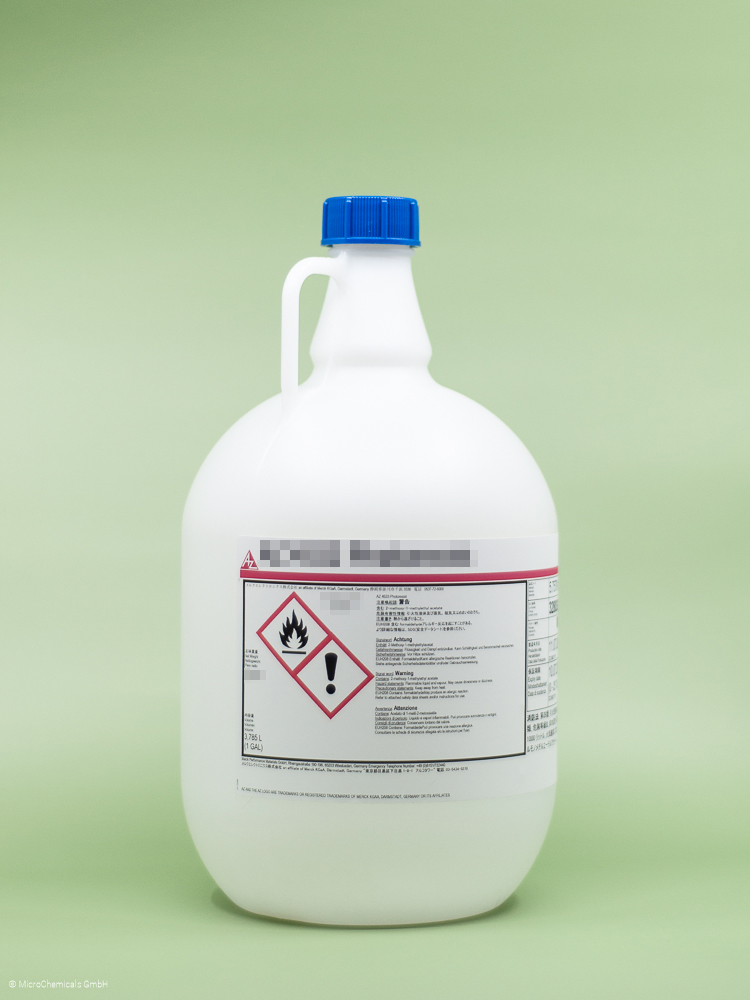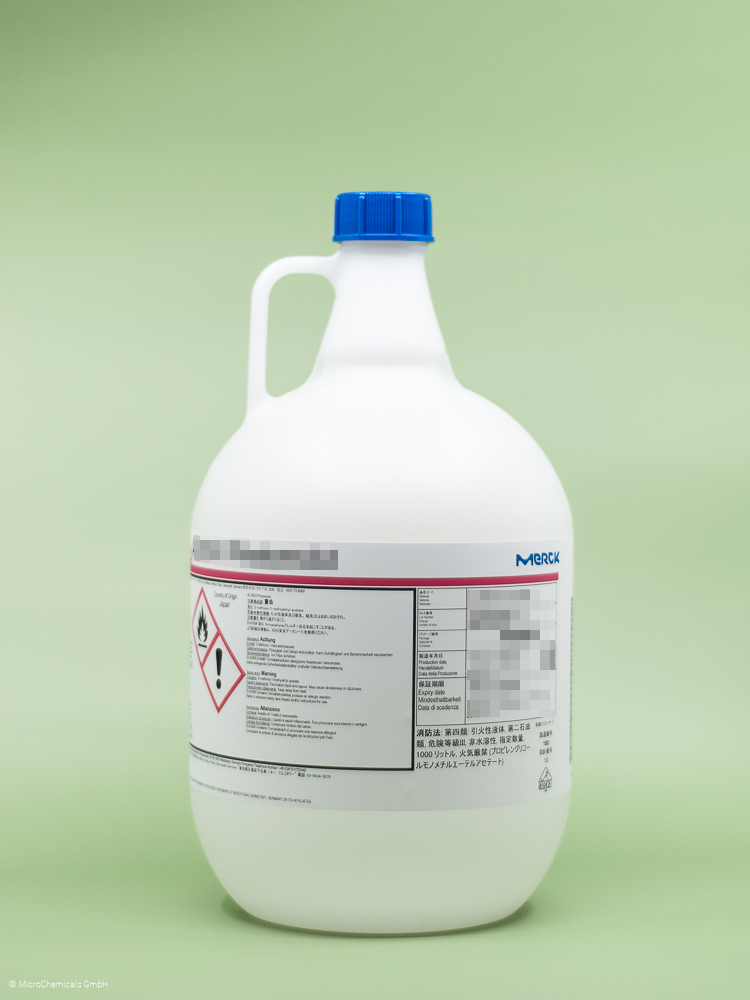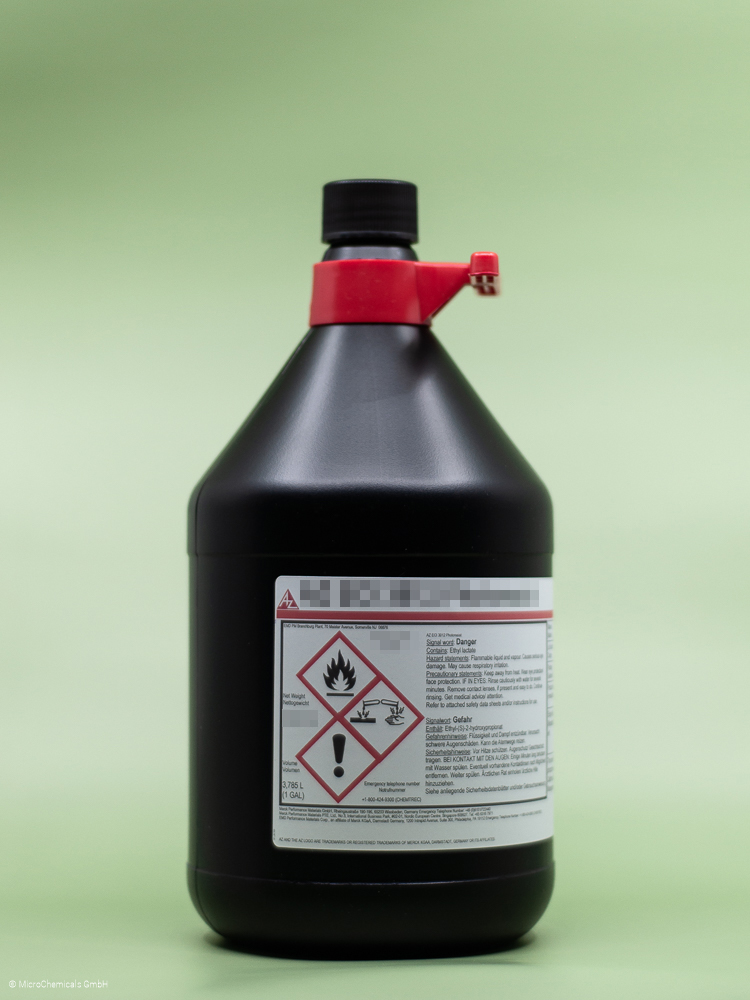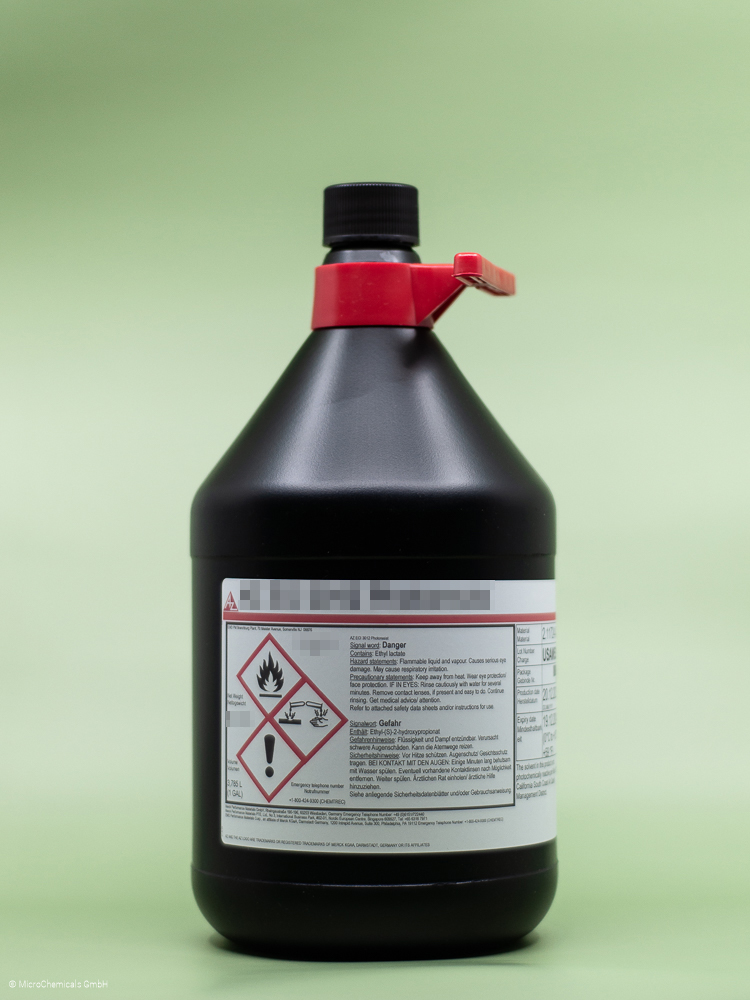POSITIVE RESISTS
Positive Thin and Thick Resists
In the case of positive resists, exposed areas are soluble in the developer due to the formation of an indene-carboxylic acid taking place during exposure, while unexposed resist areas remain on the substrate. Since positive resists do not cross-link, exceeding their softening temperature (typically 100-130 °C) leads to a rounding of the resist profiles, which is sometimes undesired, sometimes intentionally applied for certain applications.
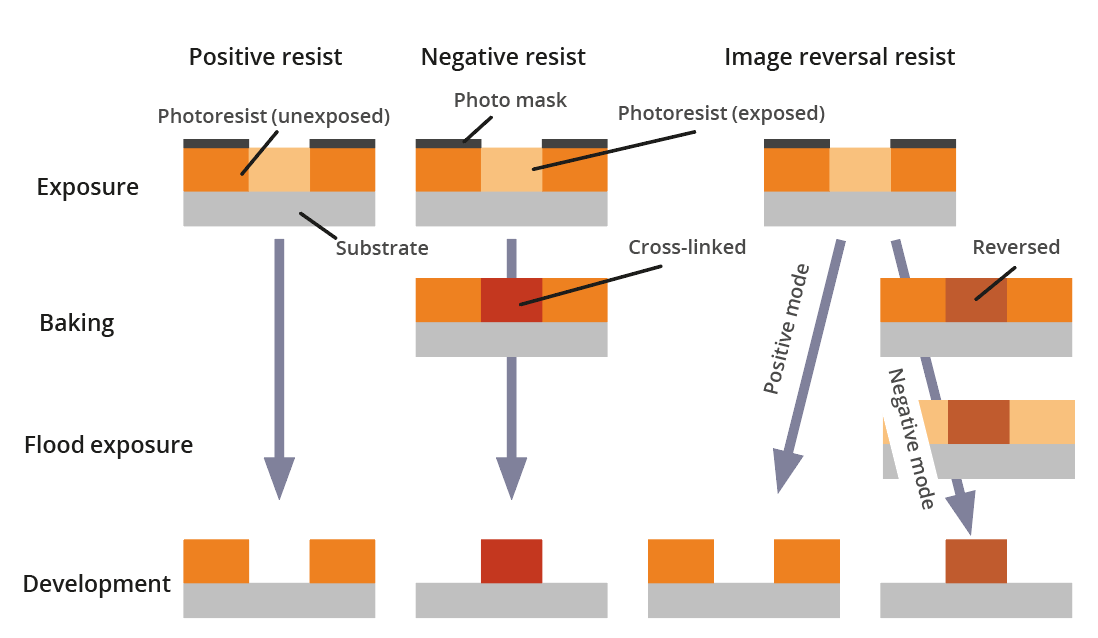
The schematic process sequence of the exposure (above) up to the
developed resist features (below) in the processing of positive resists
(left column), negative resists (centre) and image reversal resists
(right); the latter in two possible modes. The special features of the
attainable resist profiles are not included in this scheme.
Filter products
–
24 Products
AZ 10XT Photoresist (220cP) - 3.785 l
1A10XT220
AZ® 10XT (220CPS)
Thick photoresist for high resolution
General Information
AZ® 10XT is an i- and h-line (not g- line !) sensitive positive thick photoresist, as the successor to the AZ® 9260 and is largely identical in construction, but with a different surfactant. In contrast to the similarly named AZ® 12XT, the AZ® 10XT is not chemically amplified.
3.0 µm lines in 12 µm thick AZ® 10XT Ultratech 1500 Exposure, AZ® 400K Developer 1:4 (260s spray)
Product Features
AZ® 10XT not only has optimized resist adhesion to common substrate materials, but also the potential for very steep resist sidewalls and high aspect ratios. Accordingly, the AZ® 10XT is often used in electroplating, ion implantation or dry etching/RIE. AZ® 10XT achieves a resist film thickness of approx. 6 µm at a spin speed of 4000 rpm; with an appropriately adjusted spin profile, the resist film thickness range of approx. 4.5 - 20 µm can be covered. If thinner resist layers are desired, the AZ® 10XT can be diluted with PGMEA; alternatively, the thinner AZ® 4533 can also be used for many applications. From a resist film thickness of approximately 10 - 15 µm, processing the AZ® 10XT becomes increasingly time-consuming: the soft bake and subsequent development take longer, more and more time is needed for rehydration between soft bake and exposure, and the risk of nitrogen bubbles forming during exposure increases. For resist film thicknesses greater than 10 µm, it is recommended to consider using a chemically amplified thick resist such as AZ® 12 XT (5 - 20 µm resist film thickness) or AZ®IPS 6090 (> 20 µm resist film thickness), which have significantly shorter soft bake and development times for the corresponding resist thickness, do not need rehydration, require significantly lower exposure doses, and do not release nitrogen during exposure.
Developers
For development, we recommend either TMAH-based developers such as the ready-to-use AZ® 326 MIF or AZ® 726 MIF, or the KOH-based AZ® 400K 1:4 (typically 1: 4 diluted with water, for faster development also slightly stronger with 1:3.5 or 1:3). On alkaline-sensitive substrate materials such as aluminum, we recommend the aluminum-compatible, undiluted AZ® Developer.
Removers
If the resist structures have not been thermally cross-linked by plasma processes, ion implantation or high temperatures (> approx. 140 °C), all common removers such as AZ® 100 Remover, DMSO or many other organic solvents (e.g. Acetone rinsed with Isopropanol) are suitable for removing the resist layer. For cross-linked resist structures, high-performance strippers such as the NMP-free TechniStrip P1316 or AZ® 920 Remover are recommended, and in the case of alkaline-sensitive substrate materials (such as aluminum), the TechniStrip MLO 07.
Thinning / Edge Wall Removal
If the resist is to be diluted for spin coating, PGMEA = AZ® EBR Solvent is the recommended solvent. PGMEA is the solvent for AZ® 10 XT anyway and is also recommended for edge wall removal if necessary.
Further Information
Our safety data sheets and some of our technical data sheets are password-protected.
You will receive the access data after completing the form.
The access data for the data sheets are not your login data from our shop!
MSDS:
Safety Data Sheet AZ® 10XT (220cps) english
Safety Data Sheet AZ® 10XT (220cps) german
TDS:
Technical Data Sheet AZ® 10XT (220cps) english
Application Notes:
Further Information about Photoresist Processing
AZ 10XT Photoresist (520cP) - 3.785 l
1A010XT00
Bottle size:
3.785 l
AZ® 10XT (520CPS)
Thick photoresist for high resolution
General Information
AZ® 10XT is an i- and h-line (not g- line !) sensitive positive thick photoresist, as the successor to the AZ® 9260 and is largely identical in construction, but with a different surfactant. In contrast to the similarly named AZ® 12XT, the AZ® 10XT is not chemically amplified.
3.0 µm lines in 12 µm thick AZ® 10XT Ultratech 1500 Exposure, AZ® 400K Developer 1:4 (260s spray)
Product Features
AZ® 10XT not only has optimized resist adhesion to common substrate materials, but also the potential for very steep resist sidewalls and high aspect ratios. Accordingly, the AZ® 10XT is often used in electroplating, ion implantation or dry etching/RIE. AZ® 10XT achieves a resist film thickness of approx. 6 µm at a spin speed of 4000 rpm; with an appropriately adjusted spin profile, the resist film thickness range of approx. 4.5 - 20 µm can be covered. If thinner resist layers are desired, the AZ® 10XT can be diluted with PGMEA; alternatively, the thinner AZ® 4533 can also be used for many applications. From a resist film thickness of approximately 10 - 15 µm, processing the AZ® 10XT becomes increasingly time-consuming: the soft bake and subsequent development take longer, more and more time is needed for rehydration between soft bake and exposure, and the risk of nitrogen bubbles forming during exposure increases. For resist film thicknesses greater than 10 µm, it is recommended to consider using a chemically amplified thick resist such as AZ® 12 XT (5 - 20 µm resist film thickness) or AZ®IPS 6090 (> 20 µm resist film thickness), which have significantly shorter soft bake and development times for the corresponding resist thickness, do not need rehydration, require significantly lower exposure doses, and do not release nitrogen during exposure.
Developers
For development, we recommend either TMAH-based developers such as the ready-to-use AZ® 326 MIF or AZ® 726 MIF, or the KOH-based AZ® 400K 1:4 (typically 1: 4 diluted with water, for faster development also slightly stronger with 1:3.5 or 1:3). On alkaline-sensitive substrate materials such as aluminum, we recommend the aluminum-compatible, undiluted AZ® Developer.
Removers
If the resist structures have not been thermally cross-linked by plasma processes, ion implantation or high temperatures (> approx. 140 °C), all common removers such as AZ® 100 Remover, DMSO or many other organic solvents (e.g. Acetone rinsed with Isopropanol) are suitable for removing the resist layer. For cross-linked resist structures, high-performance strippers such as the NMP-free TechniStrip P1316 or AZ® 920 Remover are recommended, and in the case of alkaline-sensitive substrate materials (such as aluminum), the TechniStrip MLO 07.
Thinning / Edge Wall Removal
If the resist is to be diluted for spin coating, PGMEA = AZ® EBR Solvent is the recommended solvent. PGMEA is the solvent for AZ® 10 XT anyway and is also recommended for edge wall removal if necessary.
Further Information
Our safety data sheets and some of our technical data sheets are password-protected.
You will receive the access data after completing the form.
The access data for the data sheets are not your login data from our shop!
MSDS:
Safety Data Sheet AZ® 10XT (520cps) english
Safety Data Sheet AZ® 10XT (520cps) german
TDS:
Technical Data Sheet AZ® 10XT (520cps) english
Anwendungshinweis:
Further Information about Photoresist Processing
AZ 12XT-20PL-10 Photoresist - 3.785 l
1A012XT1000
Bottle size:
3.785 l
AZ® 12XT-20PL-10
Chemically Amplified Positive Tone Photoresists
General Information
AZ® 12XT is a chemically amplified, i-line sensitive thick photoresist for high aspect ratios and with an increased thermal softening point.
AZ® 12XT - 2.4mm lines at 10mm film thickness
Product Features
AZ® 12XT covers a resist film thickness range of approx. 5 - 20 µm. As a chemically amplified resist, the AZ® 12XT does not require rehydration between softbake and exposure, requires significantly lower exposure doses compared to non-chemically amplified resists of comparable thickness, does not release nitrogen during exposure (no bubble formation in the resist film during exposure), and has very high development rates for a thick resist. These properties help to make the entire process significantly faster and less prone to problems than with non-chemically amplified thick resists. Its good adhesion to all common substrate materials and its potential for steep resist sidewalls make it suitable for galvanic molding, and its high thermal softening point (approx. 130 °C) also recommends it for dry etching or DRIE. Basically, the AZ® 12XT is only sensitive to i-line, but with correspondingly high exposure doses and resist film thicknesses, the h-line (405 nm) can also be used. If resist film thicknesses of less than approx. 5 µm are required, the AZ® 12XT can easily be diluted with PGMEA = AZ® EBR Solvent. For resist film thicknesses greater than 15 µm, the chemically amplified AZ® IPS 6090 should be considered.
Developers
TMAH-based developers such as the ready-to-use AZ® 326 MIF or AZ® 726 MIF are recommended for developing this chemically amplified photoresist. KOH- or NaOH-based developers such as the AZ® 400 K or AZ® 351B are less suitable for the AZ® 12 XT.
Removers
If the resist structures have not been thermally cross-linked by plasma processes, ion implantation or high temperatures (> approx. 140 °C), all common removers such as AZ® 100 Remover, DMSO or many other organic solvents (e.g. acetone rinsed with isopropanol) are suitable for removing the resist layer. For cross-linked resist structures, high-performance strippers such as the NMP-free TechniStrip P1316 or AZ® 920 Remover are recommended, and in the case of alkaline-sensitive substrate materials (such as aluminum), the TechniStrip MLO 07.
Thinning/ Edge Bead Removal
If the resist is to be diluted for spin coating, PGMEA = AZ® EBR Solvent is an option. PGMEA is the solvent for AZ® 12 XT anyway and is also recommended for edge wall removal if necessary.
Further Information
Our safety data sheets and some of our technical data sheets are password-protected.
You will receive the access data after completing the form.
The access data for the data sheets are not your login data from our shop!
MSDS:
Safety Data Sheet AZ® 12XT 20PL-10 english
Safety Data Sheet AZ® 12XT 20PL-10 german
TDS:
Technical Data Sheet AZ® 12XT 20PL-10 english
Application Notes:
Further Information about Photoresist Processing
AZ 12XT-20PL-15 Photoresist - 3.785 l
1A012XT1500
AZ® 12XT-20PL-15
Chemically Amplified Positive Tone Photoresists
General Information
AZ® 12XT is a chemically amplified, i-line sensitive thick photoresist for high aspect ratios and with an increased thermal softening point.
AZ® 12XT - 2.4mm lines at 10mm film thickness
Product Features
AZ® 12XT covers a resist film thickness range of approx. 5 - 20 µm. As a chemically amplified resist, the AZ® 12XT does not require rehydration between softbake and exposure, requires significantly lower exposure doses compared to non-chemically amplified resists of comparable thickness, does not release nitrogen during exposure (no bubble formation in the resist film during exposure), and has very high development rates for a thick resist. These properties help to make the entire process significantly faster and less prone to problems than with non-chemically amplified thick resists. Its good adhesion to all common substrate materials and its potential for steep resist sidewalls make it suitable for galvanic molding, and its high thermal softening point (approx. 130 °C) also recommends it for dry etching or DRIE. Basically, the AZ® 12XT is only sensitive to i-line, but with correspondingly high exposure doses and resist film thicknesses, the h-line (405 nm) can also be used. If resist film thicknesses of less than approx. 5 µm are required, the AZ® 12XT can easily be diluted with PGMEA = AZ® EBR Solvent. For resist film thicknesses greater than 15 µm, the chemically amplified AZ® IPS 6090 should be considered.
Developers
TMAH-based developers such as the ready-to-use AZ® 326 MIF or AZ® 726 MIF are recommended for developing this chemically amplified photoresist. KOH- or NaOH-based developers such as the AZ® 400 K or AZ® 351B are less suitable for the AZ® 12 XT.
Removers
If the resist structures have not been thermally cross-linked by plasma processes, ion implantation or high temperatures (> approx. 140 °C), all common removers such as AZ® 100 Remover, DMSO or many other organic solvents (e.g. acetone rinsed with isopropanol) are suitable for removing the resist layer. For cross-linked resist structures, high-performance strippers such as the NMP-free TechniStrip P1316 or AZ® 920 Remover are recommended, and in the case of alkaline-sensitive substrate materials (such as aluminum), the TechniStrip MLO 07.
Thinning/ Edge Wall Removal
If the resist is to be diluted for spin coating, PGMEA = AZ® EBR Solvent is an option. PGMEA is the solvent for AZ® 12 XT anyway and is also recommended for edge wall removal if necessary.
Further Information
Our safety data sheets and some of our technical data sheets are password-protected.
You will receive the access data after completing the form.
The access data for the data sheets are not your login data from our shop!
MSDS:
Safety Data Sheet AZ® 12XT 20PL-15 english
Safety Data Sheet AZ® 12XT 20PL-15 german
TDS:
Technical Data Sheet AZ® 12XT 20PL-15 english
Application Notes:
Further Information about Photoresist Processing
AZ 1505 Photoresist - 3.785 l
1A001505
Bottle size:
3.785 l
AZ® 1505
Positive Thin Resists for Wet Etching
General Information
The AZ® 1505 Photoresist belongs to the AZ® 1500 Photoresist Series of positive thin resists (g-, h- and i-line sensitive) with optimized adhesion to all common substrate materials, the main application of which is as a resist mask for wet etching.
Product Properties
AZ® 1500 Resist Family is not optimized for very steep resist sidewalls nor for high stability against thermal softening (softening temperature approx. 100 °C), but for improved adhesion to all common substrate materials. The high photoinitiator concentration of the AZ® 1500 Photoresist Series compared to thick resists allows for very fast development.
AZ® 1505 Photoresist is the thinnest member of the AZ® 1500 Photoresist Series with a resist film thickness of approx. 500 nm at 4000 rpm. This resist is often used for chrome etching in photomask production, but is also suitable as an etching mask for other materials. AZ® 1505 allows a resolution in the submicrometer range under optimized process parameters. If such a high resolution is not required, a slightly thicker resist (for example AZ® 1514 H Photoresist or AZ® 1518 Photoresist) can be useful, which reduces the risk of pinholes in the resist film caused by particles on the substrate and the corresponding etching defects. Further dilution of the AZ® 1505 is not recommended, as heavily diluted, photoinitiator-rich resists tend to quickly form particles. If the resist does have to be diluted, the corresponding batches should be used up quickly and attention should be paid to possible particle formation.
Developers
For development, we recommend either TMAH-based developers such as AZ® 326 MIF or AZ® 726 MIF, the NaOH-based AZ® 351B, and if the requirements for selectivity are not too high, the KOH-based AZ® 400K. With AZ® 351Bor AZ® 400K, it may be advisable to work with a higher diluted developer (for example 1:5 to 1:6) instead of the usual 1:4 dilution to achieve very fine resist structures or better controllable development times. On alkaline-sensitive substrate materials such as aluminum, we recommend the aluminum-compatible AZ® Developer in a 1:1 dilution.
Removers
If the resist structures have not been thermally cross-linked by plasma processes, ion implantation or high temperatures (> approx. 140°C), all common removers such as AZ® 100 Remover, DMSO or many other organic solvents (e.g. acetone rinsed with isopropyl alcohol) are suitable for removing the resist layer. For cross-linked resist structures, high-performance strippers such as the NMP-free TechniStrip P1316 or AZ® 920 Remover are recommended, and in the case of alkaline-sensitive substrate materials (such as aluminum), the TechniStrip MLO 07.
Thinning/ Edge Bead Removal
Even if, as described above, further dilution of AZ® 1505 Photoresist is not recommended due to the accelerated particle formation, PGMEA = AZ® EBR Solvent is the recommended solvent. PGMEA is the solvent for AZ® 1505 anyway and is also recommended for edge wall removal if necessary.
Further Information
Our safety data sheets and some of our technical data sheets are password-protected.
You will receive the access data after completing the form.
The access data for the data sheets are not your login data from our shop!
MSDS:
Safety Data Sheet AZ® 1505 Photoresist english
Safety Data Sheet AZ® 1505 Photoresist german
TDS:
Technical Data Sheet AZ® 1505 Photoresist english
Application Notes:
Further Information about Photoresist Processing
AZ 1512 HS Photoresist - 3.785 l
1A001512
Bottle size:
3.785 l
AZ® 1512 HS
Positive Thin Resists for Wet Etching
General Information
The AZ® 1512 HS Photoresist belongs to the AZ® 1500 Photoresist Series of positive thin resists (g-, h- and i-line sensitive) with optimized adhesion to all common substrate materials, the main application of which is as a resist mask for wet etching.
Product Properties
AZ® 1500 Resist Family is not optimized for very steep resist sidewalls nor for high stability against thermal softening (softening temperature approx. 100°C), but for improved adhesion to all common substrate materials. The high photoinitiator concentration of the AZ® 1500 Photoresist Series compared to thick resists allows for very fast development.
AZ® 1512 HS Photoresist achieves a resist film thickness of approx. 1.3 µm at 4000 rpm and is often used for chrome etching in photomask production, but is also suitable as an etching mask for other materials. AZ® 1512 HS allows a resolution in the submicrometer range under optimized process parameters. If such a high resolution is not required, a slightly thicker resist (for example AZ® 1518 Photoresist) can be useful, which reduces the risk of pinholes in the resist layer caused by particles on the substrate and the corresponding etching defects. AZ® 1512 HS Photoresist has the highest photoinitiator concentration within the AZ® 1500 Photoresist Series, is correspondingly high in contrast, and shows a particularly high development rate. Diluting the AZ® 1512 HS is not advisable, as diluted resists that are very rich in photoinitiators tend to quickly form particles. If the resist still needs to be diluted, the corresponding amounts should be used up quickly and attention should be paid to possible particle formation.
Developers
For development, we recommend either TMAH-based developers such as AZ® 326 MIF or AZ® 726 MIF, the NaOH-based AZ® 351B (typically 1:4 diluted with water), and if the selectivity requirements are not too high, the KOH-based AZ® 400K (also typically 1:4 diluted with water). For very fine resist structures, a slightly higher dilution of the developer can be helpful. On alkaline-sensitive substrate materials such as aluminum, we recommend the aluminum-compatible AZ® Developer in a 2:1 to 1:1 dilution (developer : water).
Removers
If the resist structures have not been thermally cross-linked by plasma processes, ion implantation or high temperatures (> approx. 140°C), all common removers such as AZ® 100 Remover, DMSO or many other organic solvents (e.g. acetone rinsed with isopropyl alcohol) are suitable for removing the resist layer. For cross-linked resist structures, high-performance strippers such as the NMP-free TechniStrip P1316 or AZ® 920 Remover are recommended, and in the case of alkaline-sensitive substrate materials (such as aluminum), the TechniStrip MLO 07.
Thinning/ Edge Bead Removal
Even if, as described above, further dilution of AZ® 1515 HS Photoresistis not recommended due to the accelerated particle formation, PGMEA = AZ® EBR Solvent is the recommended solvent. PGMEA is the solvent for AZ® 1512 HS anyway and is also recommended for edge wall removal if necessary.
Further Information
Our safety data sheets and some of our technical data sheets are password-protected.
You will receive the access data after completing the form.
The access data for the data sheets are not your login data from our shop!
MSDS:
Safety Data Sheet AZ® 1512 HS Photoresist english
Safety Data Sheet AZ® 1512 HS Photoresist german
TDS:
Technical Data Sheet AZ® 1512 HS Photoresist english
Application Notes:
Further Information about Photoresist Processing
AZ 1514 H Photoresist - 3.785 l
1A001514
Bottle size:
3.785 l
AZ® 1514 H
Positive Thin Resist for Wet Etching
General Information
The AZ® 1514 H Photoresist belongs to the AZ® 1500 Photoresist Series of positive thin resists (g-, h- and i-line sensitive) with optimized adhesion to all common substrate materials, the main application of which is as a resist mask for wet etching.
Product Properties
AZ® 1500 Resist Family is not optimized for very steep resist sidewalls nor for high stability against thermal softening (softening temperature approx. 100°C), but for improved adhesion to all common substrate materials. The high photoinitiator concentration of the AZ® 1500 Photoresist Series compared to thick resists allows for very fast development.
AZ® 1514 H Photoresist achieves a resist film thickness of approx. 1.5 µm at 4000 rpm and has particularly good adhesion to metallic substrate materials, making it suitable as an etching mask for aluminum, chrome and other metals, for example, but also for etching non-metallic layers. It is not advisable to dilute the AZ® 1514 H Photoresist too much, as diluted, photoinitiator-rich resists tend to quickly form particles. If the resist does need to be diluted, the corresponding amounts should be used up quickly and attention should be paid to possible particle formation.
Developers
For development, we recommend either TMAH-based developers such as the ready-to-use AZ® 326 MIF or AZ® 726 MIF, the NaOH-based AZ® 351B (typically 1:4 diluted with water), and if the selectivity requirements are not too high, the KOH-based AZ® 400K (also typically 1:4 diluted with water). For very fine resist structures, a slightly higher dilution of the developer can be helpful. On alkaline-sensitive substrate materials such as aluminum, we recommend the aluminum-compatible AZ® Developer in a 2:1 to 1:1 dilution (developer : water).
Removers
If the resist structures have not been thermally cross-linked by plasma processes, ion implantation or high temperatures (> approx. 140°C), all common removers such as AZ® 100 Remover, DMSO or many other organic solvents (e.g. acetone rinsed with isopropyl alcohol) are suitable for removing the resist layer. For cross-linked resist structures, high-performance strippers such as the NMP-free TechniStrip P1316 or AZ® 920 Remover are recommended, and in the case of alkaline-sensitive substrate materials (such as aluminum), the TechniStrip MLO 07.
Thinning/ Edge Bead Removal
Even if, as described above, further dilution of AZ® 1514 H Photoresist is not recommended due to the accelerated particle formation, PGMEA = AZ® EBR Solvent is the recommended solvent. PGMEA is the solvent for AZ® 1514 H anyway and is also recommended for edge wall removal if necessary.
Further Information
Our safety data sheets and some of our technical data sheets are password-protected.
You will receive the access data after completing the form.
The access data for the data sheets are not your login data from our shop!
MSDS:
Safety Data Sheet AZ® 1514 H Photoresist english
Safety Data Sheet AZ® 1514 H Photoresist german
TDS:
Technical Data Sheet AZ® 1514 H Photoresist english
Application Notes:
Further Information about Photoresist Processing
AZ 1518 Photoresist - 3.785 l
1A001518
Bottle size:
3.785 l
AZ® 1518
Positive Thin Resist for Wet Etching
General Information
AZ® 1518 belongs to the AZ® 1500 photoresist series of positive thin resists (g-, h- and i-line sensitive) with optimized adhesion to all common substrate materials, the main application of which is as a resist mask for wet etching.
Product Properties
AZ® 1500 resist family is not optimized for very steep resist sidewalls nor for high stability against thermal softening (softening temperature approx. 100 °C), but for improved adhesion to all common substrate materials. The high photoinitiator concentration of the AZ® 1500 series compared to thick resists allows for very fast development.
AZ® 1518 achieves a resist film thickness of approx. 1.8 µm at 4000 rpm and is often used for etching metallic or non-metallic layers. It is not advisable to dilute the AZ® 1518 below the level of the AZ® 1505, as diluted, photoinitiator-rich resists tend to quickly form particles. If the resist does have to be diluted, the corresponding amounts should be used up quickly and attention should be paid to possible particle formation. AZ® 1518 should not be processed with a resist film thickness significantly thicker than approx. 2 µm, as the high photoinitiator concentration can lead to the formation of nitrogen bubbles in the resist film when exposed to light as the resist thickness increases. If thicker resist films are required, the AZ® 4533, which has a significantly lower photoinitiator content, is recommended.
Developers
For development, we recommend either TMAH-based developers such as the ready-to-use AZ® 326 MIF or AZ® 726 MIF, the NaOH-based AZ® 351B (typically 1: 4 diluted with water), and if the selectivity requirements are not too high, the KOH-based AZ® 400K K (also typically 1:4 diluted with water). On alkaline-sensitive substrate materials such as aluminum, we recommend the aluminum-compatible AZ® Developer in a 2: 1 to 1:1 dilution (developer:water).
Removers
If the resist structures have not been thermally cross-linked by plasma processes, ion implantation or high temperatures (> approx. 140 °C), all common removers such as AZ® 100 Remover, DMSO or many other organic solvents (e.g. acetone rinsed with isopropanol) are suitable for removing the resist layer. For cross-linked resist structures, high-performance strippers such as the NMP-free TechniStrip P1316 or AZ® 920 Remover are recommended, and in the case of alkaline-sensitive substrate materials (such as aluminum), the TechniStrip MLO 07.
Thinning/ Edge Bead Removal
Even if, as described above, a stronger dilution of AZ® 1518 is not recommended due to the accelerated particle formation, PGMEA = AZ® EBR Solvent.is the recommended solvent. PGMEA is the solvent for AZ® 1518 anyway and is also recommended for edge wall removal if necessary.
Further Information
Our safety data sheets and some of our technical data sheets are password-protected.
You will receive the access data after completing the form.
The access data for the data sheets are not your login data from our shop!
MSDS:
Safety Data Sheet AZ® 1518 Photoresist english
Safety Data Sheet AZ® 1518 Photoresist german
TDS:
Technical Data Sheet AZ® 1518 Photoresist english
Application Notes:
Further Information about Photoresist Processing)
AZ 3DT-102M-15 - 3.785 l
13DT102153
AZ® 3DT-102M-15
Chemically Amplified Positive Photoresist
General Information
AZ® 3DT-102M-15 is a chemically amplified positive tone photoresist with a very high aspect ratio. It is intended for the use as a mask for dry etching, ion implantation, RDL and electroplating applications (Cu-compatible). It can be used with i-line steppers as well as with conventional mask aligners. The AZ® 3DT-102M-15 is intended for a thickness range of 8 - 20 µm.
Product Properties
Steep sidewalls
Compatible with-copper plating-processes
For TSV, implantation, RDL, electroplating, dry etching
Chemically amplified à PEB obligatory
Compatible with most photoresist stripper (e.g. AZ® 100 Remover, organic solvent based or alkaline)
i-line sensitive (can be used for broadband exposure as well)
Resist film thickness range ca. 8 - 20 µm
Developers
The recommended developers are AZ® 326 MIF or AZ® 726 MIF for the photoresist AZ® 3DT-102M-15.
Removers
The recommended strippers for the AZ® 3DT-102M-15 are AZ® 920 Remover, AZ® 100 Remover, TechniStrip P1316, TechniStrip P1331 and TechniStrip MLO07.
Thinning/ Edge Bead Removal
We recommend for thinning the AZ® EBR Solvent.
Further Information
MSDS:
Safety Data Sheet AZ® 3DT-102M-15 Photoresist english
Sicherheitsdatenblatt AZ® 3DT-102M-15 Fotolack german
TDS:
Technical Data Sheet AZ® 3DT-102M-15 Photoresist english
Application Notes:
Further Information about Photoresist Processing
AZ 40XT-11D Photoresist - 3.785 l
10040XT
Bottle size:
3.785 l
AZ® 40XT
Chemically Amplified Thick Photoresist
General Information
AZ® 40XT is a chemically amplified, i-line sensitive ultra-thick photoresist for high aspect ratios.
Lines and spaces varying from 100 to 10 µm with a 40 µm thick AZ® 40XT at 400 mJ/cm2 exposure dose
Product Features
AZ® 40XT covers a resist film thickness range of approx. 15 - 50 µm. As a chemically amplified resist, the AZ® 40XT does not require rehydration between softbake and exposure, requires significantly lower exposure doses compared to non-chemically amplified resists of comparable thickness, does not release nitrogen during exposure (no bubble formation in the resist film during exposure), and has very high development rates for a thick resist. These properties help to make the entire process significantly faster and less prone to problems than with non-chemically amplified thick resists. Its good adhesion to all common substrate materials and its potential for steep resist sidewalls make it particularly suitable for galvanic molding for e.g. Cu, Ni or Au. In principle, the AZ® 40XT is only sensitive to i-line, but with correspondingly high exposure doses and resist film thicknesses, the h-line (405 nm) can also be used. It should be noted that with these chemically amplified photoresists, the post exposure bake is not optional but mandatory in order to complete the photo reaction induced during exposure and to enable subsequent development. If thinner photoresist layers than approx. 15 µm are desired, the AZ® 40XT can easily be diluted with PGMEA = AZ® EBR Solvent. If bubbles appear in the photoresist layer during the soft bake or post exposure bake, which can occur particularly with thicker photoresist layers, either a slow temperature ramp in these baking processes or a multi-stage baking process with increasing temperatures will help. If these measures are not an option, or if the formation of bubbles cannot be avoided despite this measure, we recommend using the ultra-thick photoresist AZ® IPS 6090, which is also chemically amplified.
Developers
TMAH-based developers such as the ready-to-use AZ® 326 MIF or AZ® 726 MIF are recommended for developing this chemically amplified photoresist. KOH- or NaOH-based developers such as the AZ® 400K or AZ® 351B are less suitable for the AZ® 40XT.
Removers
If the resist structures have not been thermally cross-linked by plasma processes, ion implantation or high temperatures (> approx. 140 °C), all common removers such as AZ® 100 Remover, DMSO or many other organic solvents (e.g. acetone rinsed with isopropanol) are suitable for removing the resist layer. For cross-linked resist structures, high-performance strippers such as the NMP-free TechniStrip P1316 or AZ® 920 Remover are recommended, and in the case of alkaline-sensitive substrate materials (such as aluminum), the TechniStrip MLO 07.
Thinning/ Edge Wall Removal
If the resist is to be diluted for spin coating, PGMEA = AZ® EBR Solvent is an option. PGMEA is the solvent for AZ® 40XT.anyway and is also recommended for edge wall removal if necessary.
Further Information
Our safety data sheets and some of our technical data sheets are password-protected.
You will receive the access data after completing the form.
The access data for the data sheets are not your login data from our shop!
MSDS:
Safety Data Sheet AZ® 40XT Photoresist english
Safety Data Sheet AZ® 40XT Fotolack german
TDS:
Technical Data Sheet AZ® 40XT Photoresist english
Application Notes:
Further Information about Photoresist Processing
AZ 4533 Photoresist - 3.785 l
1A004533
Bottle size:
3.785 l
AZ® 4533
Thick Resists with Optimized Adhesion
General Information
AZ® 4533 belongs to the AZ® 4500 series of positive resists (g-, h- and i-line sensitive) in the medium resist film thickness range, the main application of which is as a resist mask for wet etching or electroplating.
Product Properties
AZ® 4500 resist family is not optimized for very steep resist sidewalls nor for high stability against thermal softening (softening temperature approx. 100 °C), but rather for very high adhesion to all common substrate materials. The low photoinitiator concentration of the AZ® 4500 series resists compared to thin resists (such as the AZ® 1500 series) allows the exposure of even thicker resist layers without the risk of nitrogen bubbles forming in the resist layer.
AZ® 4533 is often used for etching metallic or non-metallic layers. AZ® 4533 achieves a resist film thickness of approx. 3.3 µm at a spin speed of 4000 rpm. With a correspondingly adjusted spin profile, the resist film thickness range of approx. 2.5 - 5 µm can be covered. If thinner resist layers are desired, the use of the AZ® 1500 series is recommended, or a dilution of the AZ® 4533 with PGMEA = "AZ® EBR Solvent". Thicker resist layers can be achieved with the AZ® 4562, which differs from the AZ® 4533 only in the lower solvent content.
Developers
For development, we recommend either TMAH-based developers such as the ready-to-use AZ® 326 MIF or 726 MIF, or the KOH-based AZ® 400K (typically 1:4 diluted with water, for faster development also slightly stronger with 1:3.5 or 1:3). On alkaline-sensitive substrate materials such as aluminum, we recommend the aluminum-compatible, undiluted "AZ® Developer”.
Removers
If the resist structures have not been thermally cross-linked by plasma processes, ion implantation or high temperatures (> approx. 140 °C), all common removers such as AZ® 100 Remover, DMSO or many other organic solvents (e.g. acetone rinsed with isopropanol) are suitable for removing the resist layer. For cross-linked resist structures, high-performance strippers such as the NMP-free TechniStrip P1316or AZ® 920 Remover are recommended, and in the case of alkaline-sensitive substrate materials (such as aluminum), the TechniStrip MLO 07.
Thinning/ Edge Bead Removal
If the resist is to be diluted for spin coating, PGMEA = AZ® EBR Solvent is the recommended solvent. PGMEA is the solvent for AZ® 4533 anyway and is also recommended for edge wall removal if necessary.
Further Information
Our safety data sheets and some of our technical data sheets are password-protected.
You will receive the access data after completing the form.
The access data for the data sheets are not your login data from our shop!
MSDS:
Safety Data Sheet AZ® 4533 Photoresist english
Safety Data Sheet AZ® 4533 Photoresist german
TDS:
Technical Data Sheet AZ® 4533 Photoresist english
Application Notes:
Further Information about Photoresist Processing
AZ 4562 Photoresist - 3.785 l
1A004562
Bottle size:
3.785 l
AZ® 4562
Thick Resists with Optimized Adhesion
General Information
AZ® 4562 belongs to the AZ® 4500 series of positive resists (g-, h- and i-line sensitive) in the medium to high resist film thickness range, the main application of which is as a resist mask for wet etching or electroplating.
Product Properties
AZ® 4500 resist family is not optimized for very steep resist sidewalls nor for high stability against thermal softening (softening temperature approx. 100 °C), but rather for very high adhesion to all common substrate materials. The low photoinitiator concentration of the AZ® 4500 series resists compared to thin resists (such as the AZ® 1500 series) allows the exposure of even thicker resist layers without the risk of nitrogen bubbles forming in the resist layer.
AZ® 4562 is often used in electroplating or for etching metallic or non-metallic layers. AZ® 4562 achieves a resist film thickness of approx. 6 µm at a spin speed of 4000 rpm. With an appropriately adjusted spin profile, the resist film thickness range of approx. 4.5 - 20 µm can be covered. If thinner resist films are required, the AZ® 4533 is recommended, which differs from the AZ® 4562 only in the higher solvent content. From approx. 10 µm, processing the AZ® 4562 becomes increasingly time-consuming: the soft bake and subsequent development take longer, rehydration between the soft bake and exposure requires more and more time, and there is also the risk of nitrogen bubbles forming during exposure. For resist film thicknesses greater than 10-20 µm, it is recommended to consider using a chemically amplified thick resist such as AZ® 12 XT (5 -20 µm resist film thickness) or IPS 6090 (> 20 µm resist film thickness), which have significantly shorter softbake and development times at the corresponding resist thickness and do not require rehydration and significantly lower exposure doses.
Developers
For development, we recommend either TMAH-based developers such as the ready-to-use AZ® 326 MIF or 726 MIF, or the KOH-based AZ® 400K (typically 1:4 diluted with water, for faster development also slightly stronger with 1:3.5 or 1:3). On alkaline-sensitive substrate materials such as aluminum, we recommend the aluminum-compatible, undiluted AZ® Developer.
Removers
If the resist structures have not been thermally cross-linked by plasma processes, ion implantation or high temperatures (> approx. 140 °C), all common removers such as AZ® 100 Remover, DMSO or many other organic solvents (e.g. acetone rinsed with isopropanol) are suitable for removing the resist layer. For cross-linked resist structures, high-performance strippers such as the NMP-free TechniStrip P1316 or AZ® 920 Remover are recommended, and in the case of alkaline-sensitive substrate materials (such as aluminum), the TechniStrip MLO 07**.
Thinning/ Edge Bead Removal
If the resist is to be diluted for spin coating, PGMEA = AZ® EBR Solvent is the recommended solvent. PGMEA is the solvent for AZ® 4562 anyway and is also recommended for edge removal if necessary.
Further Information
Our safety data sheets and some of our technical data sheets are password-protected.
You will receive the access data after completing the form.
The access data for the data sheets are not your login data from our shop!
MSDS:
Safety Data Sheet AZ® 4562 Photoresist english
Safety Data Sheet AZ® 4562 Photoresist german
TDS:
Technical Data Sheet AZ® 4562 Photoresist english
Application Notes:
Further Information about Photoresist Processing
AZ 4999 Photoresist - 3.785 l - EUD/EVE!
1A004999
Bottle size:
3.785 l
AZ® 4999
Spray Coating
General Information
AZ®4999 is a spray coating dedicated highly transparent photoresist tailored to excel on special spray coating equipment (e.g. SUSS Delta AltaSpray) where it provides defect free and conformal coatings on devices with severe topography. Thick (several to several tens of microns) and uniform resist coatings are obtained on topography such as V-grooves and trenches with optimum coverage of sharp edges. There is no accumulation of resist in trenches. The use of AZ®4999 photoresist enables high reproducibility in volume production applications.
Product Properties
Viscosity (at 25°C): 0.52 cSt
Solids content: 4 %
Absorptivity at 398 nm: 0.1 l/(g*cm)
Spectral sensitivity: 310 nm – 440 nm
Developers
If metal ion containing developers can be used, the KOH-based AZ® 400K in a 1:4 dilution (for higher resist film thicknesses 1:3.5 - 1:3 diluted possible) is a suited developer.
If metal ion free developers have to be used, we recommend the TMAH-based AZ® 2026 MIF developer (undiluted).
Removers
For non cross-linked resist films the AZ® 100 Remover, DMSO or other common organic solvents cab be used as stripper. If the resist film is crosslinked (e. g. by high temperature steps > 140°C, during plasma processes such as dry etching, or during ion implantation), we recommend the NMP-free TechniStrip P1316 as remover. AZ® 920 Remover can be a good choice as well, in case of harsh treated, hard to remove resist residuals.
Thinning/ Edge Bead Removal
We recommend for thinning and edge bead removal the products AZ® EBR Solvent or PGMEA.
Further Information
MSDS:
Safety Data Sheet AZ® 4999 Photoresist english
Sicherheitsdatenblatt AZ® 4999 Fotolack german
TDS:
Technical Data Sheet AZ® 4999 Photoresist english
Application Notes:
Further Information about Photoresist Processing
AZ ECI 3007 Photoresist - 3.785 l
1A003007
Bottle size:
3.785 l
AZ® ECI 3007
High Resolution with Broad Process Window
General Information
AZ® ECI 3007 belongs to the AZ® ECI 3000 series of positive thin resists (g-, h- and i-line sensitive), whose main applications are as a resist mask for dry etching, RIE, ion implantation or lift-off processes.
Product Properties
AZ® ECI 3000 resist family is optimized for steep resist sidewalls and high stability against thermal softening (softening temperature approx. 125 °C). AZ® ECI 3000 resists require a significantly lower exposure dose compared to other positive resists, but still develop quickly.
AZ® ECI 3007 is the thinnest member of this resist series with a resist film thickness of approx. 700 nm at 3000 rpm. This resist is often used for dry etching, RIE or lift-off processes and, under optimized process parameters, allows a resolution well in the sub-micrometer range. If such a high resolution is not required, a slightly thicker resist from this series (for example AZ® ECI 3012, AZ® ECI 3027) can be useful. If necessary, the AZ® ECI 3007 can easily be further diluted with PGMEA = AZ® EBR Solvent. Paints from the AZ® 1500 or 4500 series are recommended for applications with high requirements for very good resist adhesion such as wet etching and galvanic deposition.
Developers
For development, we recommend either TMAH-based developers such as AZ® 326 MIF or AZ® 726 MIF, the NaOH-based AZ® 351B, and if the requirements for selectivity are not too high, the KOH-based AZ® 400K. With AZ® 351B or AZ® 400K, it may be advisable to work with a higher diluted developer (for example 1:5 to 1:6) instead of the usual 1: 4 dilution to achieve very fine resist structures or better controllable development times. On alkaline-sensitive substrate materials such as aluminum, we recommend the aluminum-compatible AZ® Developer in a 1:1 dilution.
Removers
If the resist structures have not been thermally cross-linked by plasma processes, ion implantation or high temperatures (> approx. 140 °C), all common removers such as AZ® 100 Remover, DMSO or many other organic solvents (e.g. acetone rinsed with isopropanol) are suitable for removing the resist layer. For cross-linked resist structures, high-performance strippers such as the NMP-free TechniStrip P1316 or AZ® 920 Remover are recommended, and in the case of alkaline-sensitive substrate materials (such as aluminum), the TechniStrip MLO 07.
Thinning/ Edge Bead Removal
PGMEA = AZ® EBR Solvent can generally be used as a thinner for spin coating, which can also be used to remove edge ridges if necessary.
Further Information
Our safety data sheets and some of our technical data sheets are password-protected.
You will receive the access data after completing the form.
The access data for the data sheets are not your login data from our shop!
MSDS:
Safety Data Sheet AZ® ECI 3007 Photoresist english
Safety Data Sheet AZ® ECI 3007 Photoresist german
TDS:
Technical Data Sheet AZ® ECI 3000 Series english
Application Notes:
Further Information about Photoresist Processing
AZ ECI 3012 Photoresist - 3.785 l
1A003012
Bottle size:
3.785 l
AZ® ECI 3012
High Resolution with Broad Process Window
General Information
AZ® ECI 3012 belongs to the AZ® ECI 3000 series of positive thin resists (g-, h- and i-line sensitive), whose main applications are as a resist mask for dry etching, RIE, ion implantation or lift-off processes.
450 nm resist lines with the AZ® ECI 3012 at approx. 1.2 µm film thickness.
Product Properties
AZ® ECI 3000 resist family is optimized for steep resist sidewalls and high stability against thermal softening (softening temperature approx. 125 °C). AZ® ECI 3000 resists require a significantly lower exposure dose compared to other positive resists, but still develop quickly. AZ® ECI 3012 covers the resist film thickness range of approx. 1.3 µm at 3000 rpm with adapted spin profiles. This resist is often used for dry etching, RIE or lift-off processes and allows a resolution in the sub-micrometer range under optimized process parameters. If such a high resolution is not required, a slightly thicker resist from this series (for example AZ® ECI 3027) can be useful. If thinner resist layers are required, we recommend AZ® ECI 3007, or alternatively a dilution of AZ® ECI 3012 with PGMEA = AZ® EBR Solvent. For applications with high requirements for very good resist adhesion, such as wet etching and galvanic deposition, we recommend resists from the AZ® 1500 or 4500 series.
Developers
For development, we recommend either TMAH-based developers such as AZ® 326 MIF, or 726 MIF, the NaOH-based AZ® 351B, and if the requirements for selectivity are not too high, the KOH-based AZ® 400K. with AZ® 351B or AZ® 400K, it may be advisable to work with a higher diluted developer (for example 1:5 to 1:6) instead of the usual 1: 4 dilution to achieve very fine resist structures or better controllable development times. On alkaline-sensitive substrate materials such as aluminum, we recommend the aluminum-compatible AZ® Developer in a 1:1 dilution.
Removers
If the resist structures have not been thermally cross-linked by plasma processes, ion implantation or high temperatures (> approx. 140 °C), all common removers such as AZ® 100 Remover, DMSO or many other organic solvents (e.g. acetone rinsed with isopropanol) are suitable for removing the resist layer. For cross-linked resist structures, high-performance strippers such as the NMP-free TechniStrip P1316 or AZ® 920 Remover, are recommended, and in the case of alkaline-sensitive substrate materials (such as aluminum), the TechniStrip MLO 07.
Thinning/ Edge Bead Removal
PGMEA = AZ® EBR Solvent can generally be used as a thinner for spin coating, which can also be used to remove edge ridges if necessary.
Further Information
Our safety data sheets and some of our technical data sheets are password-protected.
You will receive the access data after completing the form.
The access data for the data sheets are not your login data from our shop!
MSDS:
Safety Data Sheet AZ® ECI 3012 Photoresist english
Safety Data Sheet AZ® ECI 3012 Photoresist german
TDS:
Technical Data Sheet AZ® ECI 3012 Photoresist english
Technical Data Sheet AZ® ECI 3000 Series english
Application Notes:
Further Information about Photoresist Processing
AZ ECI 3027 Photoresist - 3.785 l
1A003027
Bottle size:
3.785 l
AZ® ECI 3027
High Resolution with Broad Process Window
General Information
AZ® ECI 3027 belongs to the AZ® ECI 3000 series of positive resists (g-, h- and i-line sensitive), whose main applications are as a resist mask for dry etching, RIE, ion implantation or lift-off processes.
900 nm resist lines with the AZ® ECI 3027 at approx. 2.7 µm resist film thickness.
Product Properties
AZ® ECI 3000 resist family is optimized for steep resist sidewalls and high stability against thermal softening (softening temperature approx. 125 °C). AZ® ECI 3000 resists require a significantly lower exposure dose compared to other positive resists, but still develop quickly.
AZ® ECI 3027 covers a resist film thickness of approx. 2.7 µm at 3000 rpm with adapted spin profiles and covers the resist film thickness range of approx. 2 - 4 µm. This resist is often used for dry etching, RIE or lift-off processes. If a resolution in the sub-micrometer range is required, a slightly thinner resist from this series (for example AZ® ECI 3012 or AZ® ECI 3007) may be useful, or alternatively a dilution of the AZ® ECI 3027 with PGMEA = AZ® EBR Solvent. For applications with high requirements for very good resist adhesion such as wet etching and galvanic deposition, resists from the AZ® 1500 or 4500 series are recommended.
Developers
For development, we recommend either TMAH-based developers such as AZ® 326 MIF or 726 MIF, the NaOH-based AZ® 351B, and if the requirements for selectivity are not too high, the KOH-based AZ® 400K. With AZ® 351B or AZ® 400K, it may be advisable to work with a higher diluted developer (for example 1:5 to 1:6) instead of the usual 1:4 dilution to achieve very fine resist structures or better controllable development times. On alkaline-sensitive substrate materials such as aluminum, we recommend the aluminum-compatible AZ® Developer in a 1:1 dilution.
Removers
If the resist structures have not been thermally cross-linked by plasma processes, ion implantation or high temperatures (> approx. 140 °C), all common removers such as AZ® 100 Remover, DMSO or many other organic solvents (e.g. acetone rinsed with isopropanol) are suitable for removing the resist layer. For cross-linked resist structures, high-performance strippers such as the NMP-free TechniStrip P1316 or AZ® 920 Remover are recommended, and in the case of alkaline-sensitive substrate materials (such as aluminum), the TechniStrip MLO 07.
Thinning/ Edge Bead Removal
PGMEA = AZ® EBR Solvent can generally be used as a thinner for spin coating, which can also be used to remove edge ridges if necessary.
Further Information
Our safety data sheets and some of our technical data sheets are password-protected.
You will receive the access data after completing the form.
The access data for the data sheets are not your login data from our shop!
MSDS:
Safety Data Sheet AZ® ECI 3027 Photoresist english
Safety Data Sheet AZ® ECI 3027 Photoresist german
TDS:
Technical Data Sheet AZ® ECI 3000 Series english
Application Notes:
Further Information about Photoresist Processing
AZ IPS-6090 Photoresist - 3.785 l
1006090
Bottle size:
3.785 l
AZ® IPS-6090
Positive Thick Resist
General Information
AZ® IPS-6090 is a chemically amplified, i-line sensitive ultra-thick photoresist for high aspect ratios.
AZ® IPS 6050 (80 µm resist film thickness)
Product Properties
AZ® IPS-6090 covers a resist film thickness range of approx. 15 - 50 µm. As a chemically amplified resist, the AZ® IPS-6090 does not require rehydration between softbake and exposure, requires significantly lower exposure doses compared to non-chemically amplified resists of comparable thickness, does not release nitrogen during exposure (no bubble formation in the resist film during exposure), and has very high development rates for a thick resist. These properties help to make the entire process significantly faster and less prone to problems than with non-chemically amplified thick resists. Its good adhesion to all common substrate materials and its potential for steep resist sidewalls make it particularly suitable for galvanic molding. In principle, the AZ® IPS-6090 is only sensitive to i-line, but with correspondingly high exposure doses and resist film thicknesses, the h-line (405 nm) can also be used. It should be noted that with these chemically amplified photoresists, the post exposure bake is not only optional, but absolutely necessary in order to complete the photoreaction induced during exposure and to enable subsequent development. If thinner photoresist layers than approx. 15 µm are desired, the AZ® IPS 6090 can easily be diluted with PGMEA = AZ® EBR Solvent.
Developers
TMAH-based developers such as the ready-to-use AZ® 326 MIF or AZ® 726 MIF are recommended for developing this chemically amplified photoresist. KOH- or NaOH-based developers such as the AZ® 400K.or AZ® 351B are less suitable for the AZ® 40 XT.
Removers
If the resist structures have not been thermally cross-linked by plasma processes, ion implantation or high temperatures (> approx. 140 °C), all common removers such as AZ® 100 Remover, DMSO or many other organic solvents (e.g. acetone rinsed with isopropanol) are suitable for removing the resist layer. For cross-linked resist structures, high-performance strippers such as the NMP-free TechniStrip P1316 or AZ® 920 Remover are recommended, and in the case of alkaline-sensitive substrate materials (such as aluminum), the TechniStrip MLO 07.
Thinning/ Edge Bead Removal
If the resist is to be diluted for spin coating, PGMEA = AZ® EBR Solvent is an option. PGMEA is the solvent for AZ® IPS-6090 anyway and is also recommended for edge ridge removal if necessary.
Further Information
Our safety data sheets and some of our technical data sheets are password-protected.
You will receive the access data after completing the form.
The access data for the data sheets are not your login data from our shop!
MSDS:
Safety Data Sheet AZ® IPS-6090 Photoresist english
Safety Data Sheet AZ® IPS-6090 Photoresist german
TDS:
Technical Data Sheet AZ® IPS-6090 english
Information AZ® IPS-6090 english
Application Notes:
Further Information about Photoresist Processing
AZ MIR 701 Photoresist (14 CPS) - 3.785 l
10070114
Bottle size:
3.785 l
AZ® MIR 701 (14CPS)
High Resolution and Temperature Stability
General Information
AZ® 701 MIR (14CPS) is a positive thin resist (g-, h- and i-line sensitive), the main application of which is as a resist mask for dry etching, RIE, or lift-off processes.
300 nm resist lines attained with the AZ® 701 MIR
1.2µm structure after 130°C hardbake
Product Features
AZ® 701 MIR (14CPS) is optimized for steep resist sidewalls and high stability against thermal softening (softening temperature approx. 130°C). AZ® 701 MIR (14CPS) achieves a resist film thickness of approx. 800 nm at a spin speed of 4000 rpm and, under optimized process parameters, allows a resolution well in the sub-micrometer range. If such a high resolution is not required and thicker resist layers are desired, the use of the higher-viscosity AZ® 701 MIR (29CPS) is recommended. If necessary, the AZ® 701 MIR (14CPS) can also be (even heavily) diluted with PGMEA = AZ® EBR Solvent. For wet-chemical etching, resists from the AZ® 1500 series with optimized resist adhesion are recommended in this resist film thickness range.
Developers
For development, we recommend either TMAH-based developers such as AZ® 326 MIF or AZ® 726 MIF, the NaOH-based AZ® 351B, and if the requirements for selectivity are not too high, the KOH-based AZ® 400K. With AZ® 351B or AZ® 400K, it may be advisable to work with a higher diluted developer (for example 1:5 to 1:6) instead of the usual 1:4 dilution to achieve very fine resist structures or better controllable development times. On alkaline-sensitive substrate materials such as aluminum, we recommend the aluminum-compatible AZ® Developer in a 1:1 dilution.
Removers
If the resist structures have not been thermally cross-linked by plasma processes, ion implantation or high temperatures (> approx. 140 °C), all common removers such as AZ® 100 Remover, DMSO or many other organic solvents (e.g. acetone rinsed with isopropyl alcohol) are suitable for removing the resist layer. For cross-linked resist structures, high-performance strippers such as the NMP-free TechniStrip P1316 or AZ® 920 Remover are recommended, and in the case of alkaline-sensitive substrate materials (such as aluminum), the TechniStrip MLO 07.
Thinning/ Edge Bead Removal
PGMEA = AZ® EBR Solvent can generally be used as a thinner for spin coating, which can also be used to remove edge ridges if necessary.
Further Information
Our safety data sheets and some of our technical data sheets are password-protected.
You will receive the access data after completing the form.
The access data for the data sheets are not your login data from our shop!
MSDS:
Safety Data Sheet AZ® MIR 701 (14CPS) Photoresist english
Safety Data Sheet AZ® MIR 701 (14CPS) Fotolack german
TDS:
Technical Data Sheet AZ® MIR 701 Series english
Application Notes:
Further Information about Photoresist Processing
AZ MIR 701 Photoresist (29 CPS) - 3.785 l
10070129
Bottle size:
3.785 l
AZ® MIR 701 (29CPS)
High Resolution and Temperature Stability
General Information
AZ® 701 MIR (29CPS) is a positive resist (g-, h- and i-line sensitive) in the medium resist film thickness range, whose main applications are as a resist mask for dry etching, RIE, or lift-off processes.
300 nm resist lines attained with the AZ® 701 MIR
1.2µm structure after 130°C hardbake
Product Features
AZ® 701 MIR (29CPS) is optimized for steep resist sidewalls and high stability against thermal softening (softening temperature approx. 130°C). It achieves a resist film thickness of approx. 2µm at a spin speed of 4000 rpm. If thinner layers or a higher resolution are desired, the use of the lower-viscosity AZ® 701 MIR (14CPS) is recommended. Alternatively, AZ® 701 MIR (14CPS) can easily be heavily diluted with PGMEA = AZ® EBR Solvent. For wet-chemical etching, resists from the AZ® 1500 series with optimized resist adhesion are recommended.
Developers
For development, we recommend either TMAH-based developers such as AZ® 326 MIF or AZ® 726 MIF, the NaOH-based AZ® 351B, and if the requirements for selectivity are not too high, the KOH-based AZ® 400K. With AZ® 351B or AZ® 400K, it may be advisable to work with a higher diluted developer (for example 1:5 to 1:6) instead of the usual 1:4 dilution to achieve very fine resist structures or better controllable development times. On alkaline-sensitive substrate materials such as aluminum, we recommend the aluminum-compatible AZ® Developer in a 1:1 dilution.
Removers
If the resist structures have not been thermally cross-linked by plasma processes, ion implantation or high temperatures (> approx. 140 °C), all common removers such as AZ® 100 Remover, DMSO or many other organic solvents (e.g. acetone rinsed with isopropyl alcohol) are suitable for removing the resist layer. For cross-linked resist structures, high-performance strippers such as the NMP-free TechniStrip P1316 or AZ® 920 Remover are recommended, and in the case of alkaline-sensitive substrate materials (such as aluminum), the TechniStrip MLO 07.
Thinning/ Edge Bead Removal
PGMEA = AZ® EBR Solvent can generally be used as a thinner for spin coating, which can also be used to remove edge ridges if necessary.
Further Information
Our safety data sheets and some of our technical data sheets are password-protected.
You will receive the access data after completing the form.
The access data for the data sheets are not your login data from our shop!
MSDS:
Safety Data Sheet AZ® MIR 701 (29CPS) Photoresist english
Safety Data Sheet AZ® MIR 701 (29CPS) Fotolack german
TDS:
Technical Data Sheet AZ® MIR 701 Series english
Application Notes:
Further Information about Photoresist Processing
AZ P4110 Photoresist - 3.785 l
1A0P4110
AZ® P4110
Positive Thick Resist - AZ® P4110, AZ® P4330, AZ® P4903, AZ® P4620
General Information
The AZ® P4000 positive resist series with its members AZ® P4110, AZ® P4330, AZ® P4620 and AZ® P4903 have two main characteristics:
An improved adhesion to all common substrates for a higher stability for e.g. wet etching or plating and a lower photo active compound concentration, which allows the application of thick and very thick resist films (approx. 1 - 30 µm). This resist series have a medium thermal stability and can be developed with common KOH or TMAH based developers.
Product Properties
Resist film thickness: 0.9 - 1.3 µm
Steep wall profiles, high aspect ratios
Sensitive to g-, h-, and i-line
Recommended developers: KOH-based (e.g. AZ® 400K) or TMAH-based (e.g. AZ® 2026 MIF)
Standard strippers (e.g. AZ® 100 Remover, TechniStrip P1316)
Thinner and edge bead remover: AZ® EBR Solvent or PGMEA
Developers
If metal ion containing developers can be used the KOH-based AZ® 400K in a 1:4 dilution or the finish diluted version AZ® 400K 1:4 (for higher resist film thicknesses 1:3.5 - 1:3 diluted possible) is a suited developer.
If metal ion free developers have to be used, we recommend the TMAH-based AZ® 2026 MIF developer (undiluted).
Removers
For non cross-linked resist films the AZ® 100 Remover, DMSO or other common organic solvents can be used as stripper. If the resist film is cross-linked (e.g. by high temperature steps > 140°C, during plasma processes, such as dry etching, or during ion implantation), we recommend the NMP-free TechniStrip P1316 as remover.
AZ® 920 Remover can be a good choice as well in case of harsh treated or hard to remove resist residuals.
Thinning/ Edge Bead Removal
We recommend for thinning and edge bead removal AZ® EBR Solvent or PGMEA. AZ® EBR70/30 Solvent is possible as well for edge bead removal.
Further Information
MSDS:
Safety Data Sheet AZ® P4110 Photoresist english
Sicherheitsdatenblatt AZ® P4110 Fotolack german
TDS:
Technical Data Sheet AZ® P4000 Series english
Information AZ® P400 Series english
Application Notes:
Further Information about Photoresist Processing
AZ P4620 Photoresist - 3.785 l
1A0P4620
Bottle size:
3.785 l
AZ® P4620
Positive Thick Resist - AZ® P4110, AZ® P4330, AZ® P4903, AZ® P4620
General Information
The AZ® P4000 positive resist series with its members AZ® P4110, AZ® P4330, AZ® P4620 and AZ® P4903 have two main characteristics:
An improved adhesion to all common substrates for a higher stability for e.g. wet etching or plating and a lower photo active compound concentration, which allows the application of thick and very thick resist films (approx. 1 - 30 µm). This resist series have a medium thermal stability and can be developed with common KOH or TMAH based developers.
AZ® P4620 (15µm holes at 24µm film thickness for Au plating)
Product Properties
Optimized resist adhesion to all common substrate materials
Broad process parameter window for stable and reproducible litho-processes
Compatible with all common developers (KOH- or TMAH-based)
Compatible with all common strippers (e. g. with AZ® 100 Remover, organic solvents or aqueous alkaline)
g-, h- and i-line sensitive (approx. 320 - 440 nm)
Resist film thickness range approx. 5 - 30 µm
Developers
If metal ion containing developers can be used the KOH-based AZ® 400K in a 1:4 dilution or the finish diluted version AZ® 400K 1:4 (for higher resist film thicknesses 1:3.5 - 1:3 diluted possible) is a suited developer.
If metal ion free developers have to be used, we recommend the TMAH-based AZ® 2026 MIF developer (undiluted).
Removers
For non cross-linked resist films the AZ® 100 Remover, DMSO or other common organic solvents can be used as stripper. If the resist film is cross-linked (e.g. by high temperature steps > 140°C, during plasma processes, such as dry etching, or during ion implantation), we recommend the NMP-free TechniStrip P1316 as remover.
AZ® 920 Remover can be a good choice as well in case of harsh treated or hard to remove resist residuals.
Thinning/ Edge Bead Removal
We recommend for thinning and edge bead removal AZ® EBR Solvent or PGMEA. AZ® EBR 70/30 Solvent is possible as well for edge bead removal.
Further Information
MSDS:
Safety Data Sheet AZ® P4620 Photoresist english
Sicherheitsdatenblatt AZ® P4620 Fotolack german
TDS:
Technical Data Sheet AZ® P4620 Photoresist english
Technical Data Sheet AZ® P4000 Series english
Information AZ® P400 Series english
Application Notes:
Further Information about Photoresist Processing
AZ P4903 Photoresist - 3.785 l
1A0P4903
AZ® P4903
Positive Thick Resist - AZ® P4110, AZ® P4330, AZ® P4903, AZ® P4620
General Information
The AZ® P4000 positive resist series with its members AZ® P4110, AZ® P4330, AZ® P4620 and AZ® P4903 have two main characteristics:
An improved adhesion to all common substrates for a higher stability for e.g. wet etching or plating and a lower photo active compound concentration, which allows the application of thick and very thick resist films (approx. 1 - 30 µm). This resist series have a medium thermal stability and can be developed with common KOH or TMAH based developers.
Product Properties
Optimized resist adhesion to all common substrate materials
Broad process parameter window for stable and reproducible litho-processes
Compatible with all common developers (KOH- or TMAH-based)
Compatible with all common strippers (e.g. with AZ® 100 Remover, organic solvents or aqueous alkaline)
g-, h- and i-line sensitive (approx. 320 - 440 nm)
Resist film thickness range approx. 10 - 35 µm
Developers
If metal ion containing developers can be used the KOH-based AZ® 400K in a 1:4 dilution or the finish diluted version AZ® 400K 1:4 (for higher resist film thicknesses 1:3.5 - 1:3 diluted possible) is a suited developer.
If metal ion free developers have to be used, we recommend the TMAH-based AZ® 2026 MIF developer (undiluted).
Removers
For non cross-linked resist films the AZ® 100 Remover, DMSO or other common organic solvents can be used as stripper. If the resist film is cross-linked (e.g. by high temperature steps > 140°C, during plasma processes, such as dry etching, or during ion implantation), we recommend the NMP-free TechniStrip P1316 as remover.
AZ® 920 Remover can be a good choice as well in case of harsh treated or hard to remove resist residuals.
Thinning/ Edge Bead Removal
We recommend for thinning and edge bead removal AZ® EBR Solvent or PGMEA. AZ® EBR70/30 Solvent is possible as well for edge bead removal.
Further Information
MSDS:
Safety Data Sheet AZ® P4903 Photoresist english
Sicherheitsdatenblatt AZ® P4903 Fotolack german
TDS:
Technical Data Sheet AZ® P4000 Series english
Information AZ® P400 Series english
Application Notes:
Further Information about Photoresist Processing
AZ TFP-650F5 (15CP) Photoresist - 3.785 l
34000511
AZ® TFP 650
Flat Panel Display Photoresist
General Information
The AZ® TFP 650 F5 resist is suitable for spin coat and extrusion coat applications excellent adhesion requirements and/or harsh etching conditions. It is designed to meet the requirements of the flat panel display industry. They are specifically optimized for a variety of applications including spin coat, extrusion coat and roller coat. These production-proven photoresists can be used with a variety of developers and removers, and they are formulated to be compatible with the underlying layers.
Product Properties
Ultra high photospeed
Low dark film loss
Optimized resist adhesion
Easy removal after hardbake
High resistance to harsh etchants
Compatible with all common strippers (e.g. with AZ® 100 Remover, organic solvents or aqueous alkaline)
g-, h- and i-line sensitive (approx. 320 - 440 nm)
Resist film thickness range approx. 1 – 2 µm
Developers
We recommend the TMAH-based AZ® 726 MIF or AZ® 326 MIF (this one contains surfactants).
Removers
For non cross-linked resist films the AZ® 100 Remover, DMSO or other common organic solvents cab be used as stripper. If the resist film is cross-linked (e.g. by high temperature steps > 140°C, during plasma processes such as dry etching, or during ion implantation), we recommend the NMP-free such as AZ® 920 Remover or TechniStrip P1316 as remover.
Thinning/ Edge Bead Removal
We recommend for thinning and edge bead removal the products AZ® EBR Solvent or PGMEA. AZ® EBR Solvent 70/30 is possible as well for edge bead removal.
Further Information
MSDS:
Safety Data Sheet AZ® TFP 650 Photoresist english
Sicherheitsdatenblatt AZ® TFP 650 Fotolack german
TDS:
Technical Data Sheet AZ® TFP 650 english
Information AZ® TFP 650 english
Application Notes:
Further Information about Photoresist Processing
PL 177 Photoresist - 3.785 l
1A000177
Bottle size:
3.785 l
AZ® PL 177
Positive Thick Resist
General Information
AZ® PL 177 is a positive tone liquid photoresist for the application in various coating techniques, especially for printed circuit boards manufacturing. AZ® PL 177 is dyed with a blue/violet colour for easy inspection after coating. It can be used for spin coating as well as for dip coating or for spray- or roller-coating. It is especially suited for wet chemical etching due to its outstanding adhesion properties and chemical stability. It is a general purpose resist and fits to all applications where high resolution and high thermal stability are not important.
The AZ® PL 177 is a more inexpensive resist for lower demands regarding resolution and sidewall steepness. With a resist film thickness of approx. 5 µm at 4000 rpm, a resolution of approx. 4 - 5 µm is possible.
Product Properties
Good drying behaviour
Aqueous-alkaline process ability
PGMEA based formulation
Very good adhesion properties to many types of substrates
Blue/violet coloured for easy inspection
Compatible with all common strippers (e.g. with AZ® 100 Remover, organic solvents, or aqueous alkaline)
g-, h- and i-line sensitive (approx. 320 - 440 nm)
Resist film thickness range approx. 4 - 8 µm
Developers
As a developer, we recommend the NaOH-based AZ® 351B, the KOH-based AZ® 400K or TMAH-based devel¬oper such as the AZ® 2026 MIF. AZ Developer and even simple aqueous KOH or NaOH solutions can be used.
Removers
For non cross-linked resist films the AZ® 100 Remover, DMSO or other common organic solvents can be used as stripper. If the resist film is cross-linked (e.g. by high temperature steps > 140°C, during plasma processes, such as dry etching, or during ion implantation), we recommend the NMP-free TechniStrip P1316 as remover.
AZ® 920 Remover can be a good choice as well in case of harsh treated or hard to remove resist residuals.
Thinning/ Edge Wall Removal
We recommend for thinning and edge bead removal AZ® EBR Solvent, PGMEA or MEK. AZ® EBR 70/30 Solvent is possible as well for edge bead removal.
Further Information
Our safety data sheets and some of our technical data sheets are password-protected.
You will receive the access data after completing the form.
The access data for the data sheets are not your login data from our shop!
MSDS:
Safety Data Sheet AZ® PL177 Photoresist english
Safety Data Sheet AZ® PL177 Photoresist german
TDS:
Technical Data Sheet AZ® PL177 Photoresist english
Application Notes:
Further Information about Photoresist Processing
